BESTIARY (19A)
By:
January 4, 2022
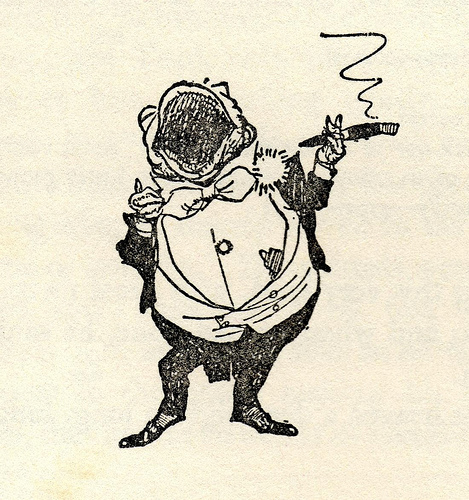
One in a series of posts — curated by Matthew Battles — the ultimate goal of which is a high-lowbrow bestiary. This particular installment is in four parts.
The frog is so extra.
Its amphibious style of life and iconic physical attributes — stout body, colorful skin, bulging eyes, elongated hindlegs, awkward gait, croaking call — tend to elicit or provoke in us an uncanny feeling of too-much-ness, neither-this-nor-that-ness, grotesquerie.
An anthropomorphic frog is cute, to be sure… but also creepy, freaky, even monstrous. Too much! But too much in what way? How has the frog’s deployment as a symbolic representation of human too-muchness evolved over time?
I’ve done a quick trawl of twentieth-century pop-culture frog depictions, mostly from the US and the UK. My findings — this is “thin description” only, i.e., preliminary work, field notes — are divided into the following chapters.
1904–1933: BUMPTIOUS FROG | 1934–1963: RAPSCALLION FROG | 1964–1983: FREE-SPIRIT FROG | 1984–2003: PALIMPSEST FROG.
Before we get to the first “leg” in this BESTIARY series installment, a few notes…
My research goal was originally to uncover twentieth-century examples of the frog-as-dandy. I’m interested in dandies. From the perspective of his critics, the nineteenth-century dandy was a puffed-up, foolish, frog-like creature. Talk about being extra. You will encounter many foppish frogs in this series! I just want to quickly suggest where this meme originated.
For one thing, in the nineteenth century, we discover a vogue for taxidermy — inspired by the German taxidemist Hermann Ploucquet, whose works were shown at London’s Great Exhibition of 1851 — in which animals were dressed and posed as humans. Because they don’t have necks, taxidermied frogs — here’s an amazing collection — are not only ridiculous looking, with their spindly bowed legs and puffed-out chests, but ridiculously snobbish-looking too. Their noses are always pointed straight up. What a perfect way to depict the dandy — who is absurdly proud, vain, and snobbish.

Randolph Caldecott — after whom the Caldecott Medal is named — really helped drive this meme, with his extremely popular 1883 children’s book A Frog He Would A-Wooing Go. Which takes as its subject the English folk song “Frog Went a-Courtin'” (Americans tend to know Chubby Parker’s version, “King Kong Kitchie Kitchie Ki-Me-O”), and which depicts the frog as an extravagantly dressed fop.
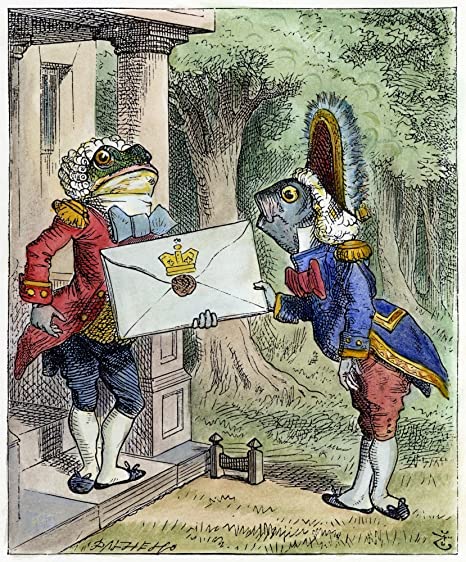
John Tenniel’s illustrations for Lewis Carroll’s Alice in Wonderland (1865) are another key source of foppish frogs.
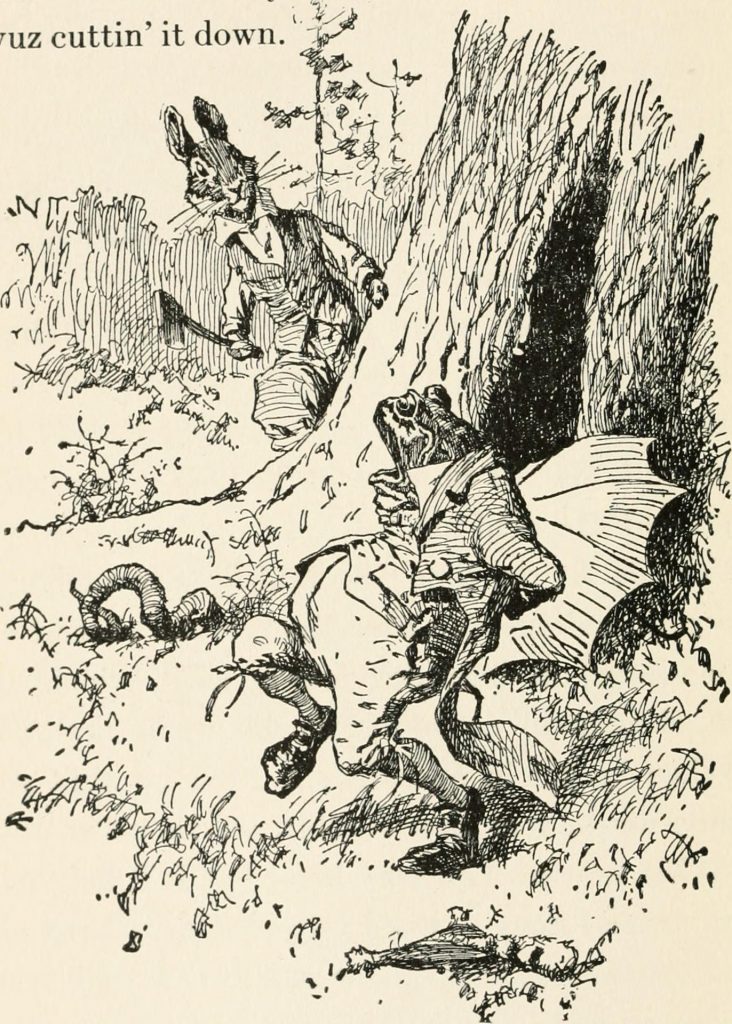
One also thinks of Joel Chandler’s Br’er Frog (c. 1881), a trickster who dresses exquisitely in a soldier’s hat with green and white speckles, a long green coat, satin breeches, a white silk waistcoat, shoes with silver buckles, and carries a green umbrella.
For this series I’ve only studied twentieth-century frogs, mostly anthropomorphized ones at that. My impression is that — with the exception of Heqet, Ancient Egypt’s frog-headed goddess of fertility — one won’t find many anthropomorphized frogs before the 18th century. Particularly in the ancient world, what you’ll find are statuettes, figurines. I have mostly ignored non-anthropomorphic 20th-century frog figurines, but here are a few fun ones: [1].
I have not devoted any attention to myths, fairy tales, and fables about frogs. However, to the extent that these are referenced by twentieth-century pop-culture frog depictions, I’ll mention them as we go along.
The frog’s bulging hemispheric eyes, not to mention its association with ancient Egypt — and with the occult in general (e.g., “eye of newt and toe of frog”) — seem to suggest a hypnotic power, an ability to bend the human will to its own purposes. I have not spent much time thinking about this topic, but here are some fun examples: [2].
Speaking of the frog’s association with the occult… I mentioned above that the frog is uncanny in form, it is an avatar of too-much-ness, neither-this-nor-that-ness. This is particularly true in the case of anthropomorphic frogs. (And frog-like humans; one thinks of Edgar Allan Poe’s 1849 horror story “Hop-Frog.”) But as Baudrillard helped us understand in Simulacres et Simulation (1981), the humanoid simulacrum can either be charming or uncanny. This series will mostly introduce you to charming frogs; for frightening humanoid frogs and frog-like humans, check out this footnote: [3].
As noted above, frogs are an ancient symbol of fertility. And as “Frog Went a-Courtin'” suggests, frogs are often depicted as lovelorn romantics. Anyone whose ever walked by a frog pond in the spring knows how desperate-sounding the male frogs can be. Throughout the first half of the twentieth century we often find frogs depicted as amorous lotharios.
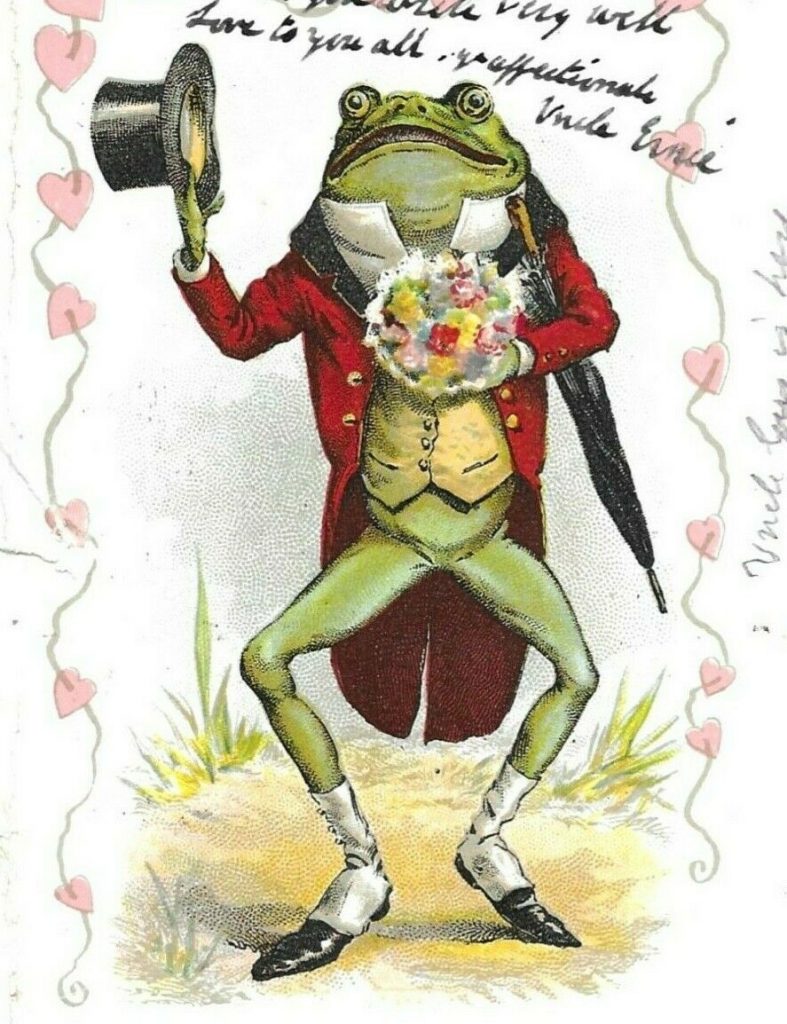
Frogs are often represented as terribly lonely and/or horny. Particularly on mass-produced valentines and greeting cards of the era.
In many myths and fables, of course, we find male frogs appearing as a potential suitor to a female human. The most famous example is “The Frog Prince.” We also find female frogs appearing as brides of male humans in the German fairy tale “Puddocky,” for example, or the Russian fairy tale “The Frog Princess.”
Sometimes this sort of thing is depicted as horrifying; frogs are monstrous creatures from a black lagoon who want to carry human women home with them. See the FRIGHTENING FROGS footnote to this post for examples.
The presence and position of a frog’s organs are similar enough to a human’s to provide insights into the internal workings of the human body. In the early 1900s, frog dissection was established in college-level Bio courses. From 1910–1920, frogs became commercially available for use in education, and during the Twenties, frog dissection became routine in high schools. For a few examples of frog-dissection ephemera, see this footnote: [4]
Because of their croaking, frogs are associated — jocularly — with music in pop culture, particularly during the first half of the twentieth century. Here are a few examples of this sort of thing: [5]
Toad is merely a folk-taxonomic term for frog — especially a dry, leathery, warty frog. So this series will include toads and frogs alike. We won’t distinguish between the two… except for those cases when pop culture distinguishes between them.
Now that we’ve taken care of these preliminaries, let’s get into the first “leg” of the four-part FROG installment in the BESTIARY series.
BUMPTIOUS
From 1904–1933, pop-culture frogs are typically symbolic representations of bumptious (foolishly prideful) humans. This is a hangover of Victorian-era norms and forms. Foppish Edwardian frogs, frequently wearing a waistcoat and bowtie, and top hats in some cases, are supposed to be figures of fun. No matter what they’re wearing, these humanoid frugs strut and preen in a comical manner. Theirs is a too-muchness of the self.
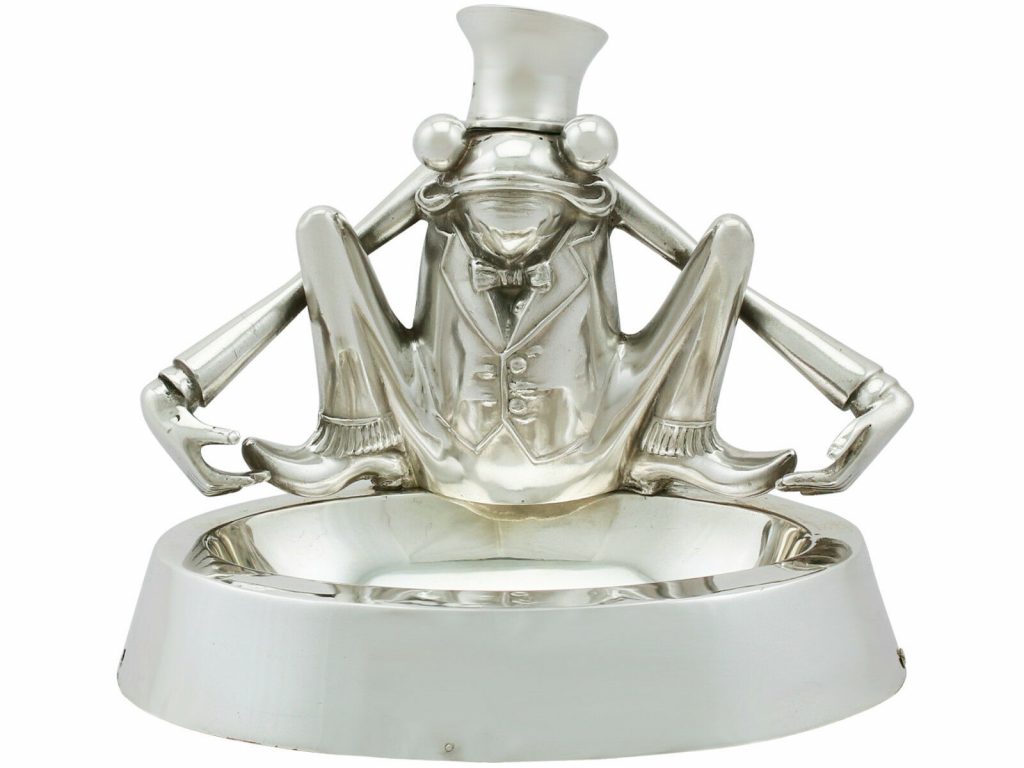
The design of this c. 1904 inkwell provides context for many depictions of Kenneth Grahame’s character Toad, as we’ll see below.
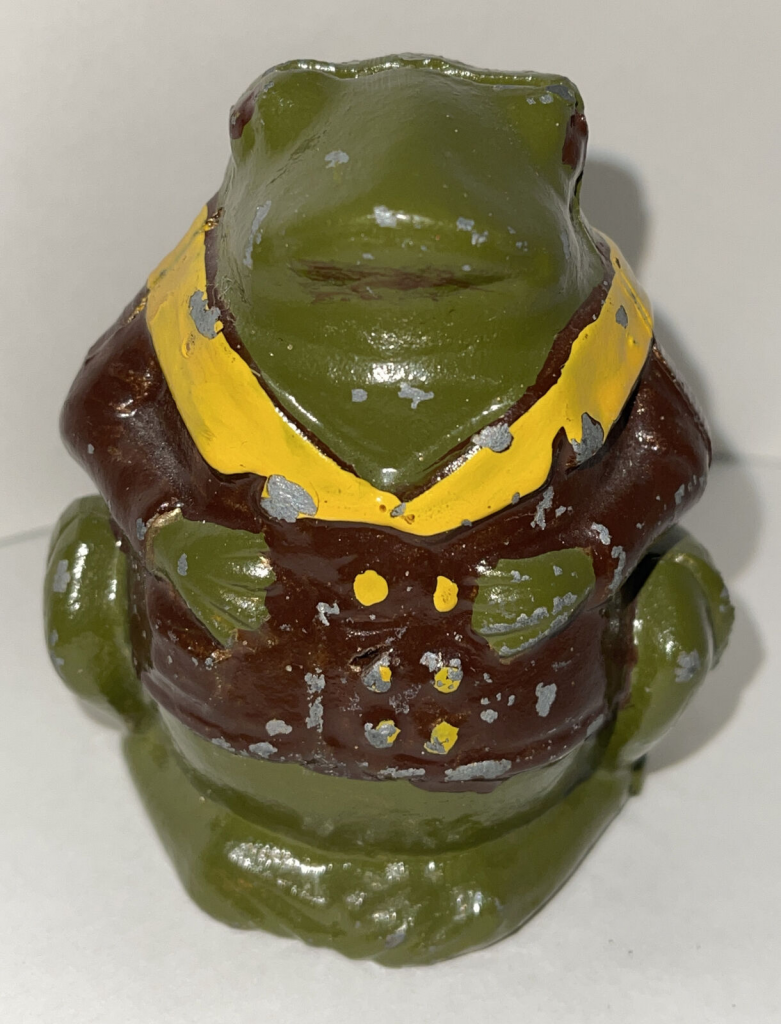
PROFESSOR PUG FROG: Professor Pug is a character developed (I believe) by the J. & E. Stevens company in Cromwell, Connecticut — which beginning in 1843 produced all sorts of iron toys, particularly mechanical banks. Professor Pug first appeared, I think, on a “Bicycle Feat” mechanical bank in the 1880s; here, he’s a bloated fellow in a waistcoat.
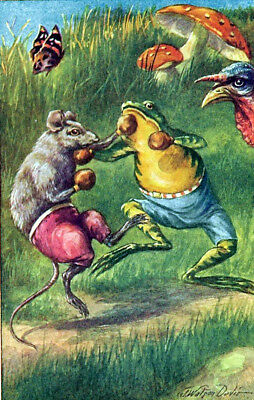
CROAKY FROG: In this scene from Croaky Frog’s Story a 1906 book by Amy Prentice (pseudonym of James Otis Kaler), Croaky boxes with a mouse. A reference, perhaps, to Caldecott’s A Frog He Would A-Wooing Go.
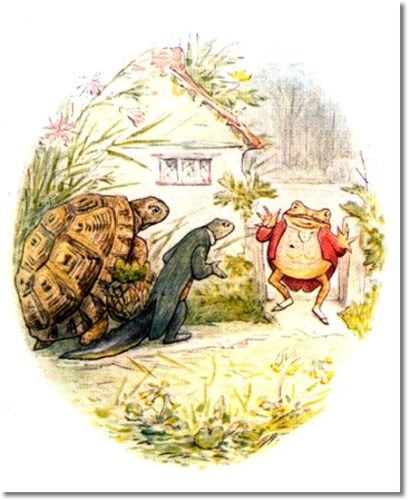
MR. JEREMY FISHER: Also published in 1906, Beatrix Potter’s children’s book The Tale of Mr. Jeremy Fisher features a spiffily dressed frog who goes fishing for dinner, but ends up serving his friends (Mr. Alderman Ptolemy Tortoise and Sir Isaac Newton) roasted grasshopper. One hears that Potter’s decision to deck the frog out in Edwardian finery is due to her admiration for Randolph Caldecott’s work.
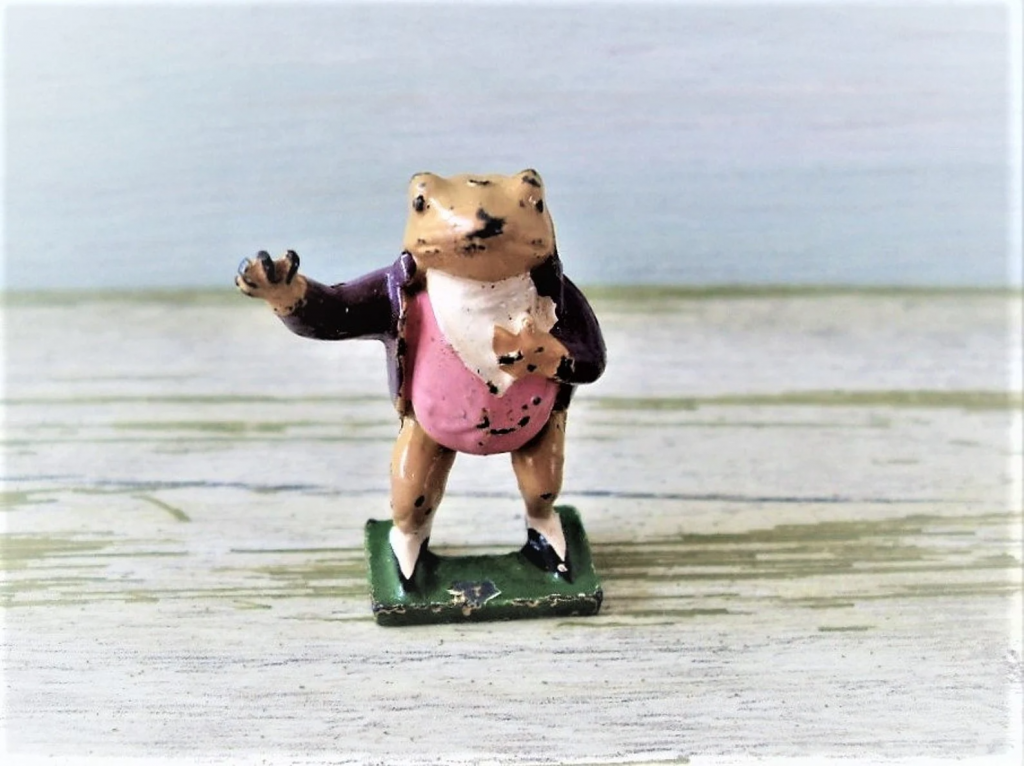
After Potter’s death in 1943, licenses were issued to various firms to produce Jeremy (see above) and other characters as porcelain figurines, plush toys, and other merchandise.
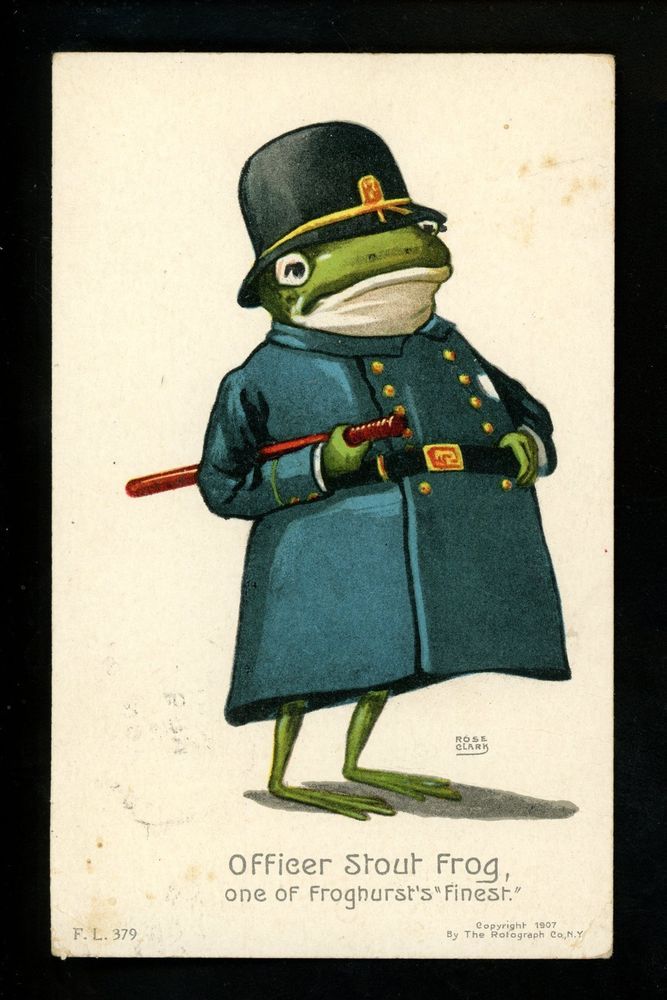
This 1907 card — illustrated by Rose Clark — is one of a series of depictions of the citizens of “Froghurst.”
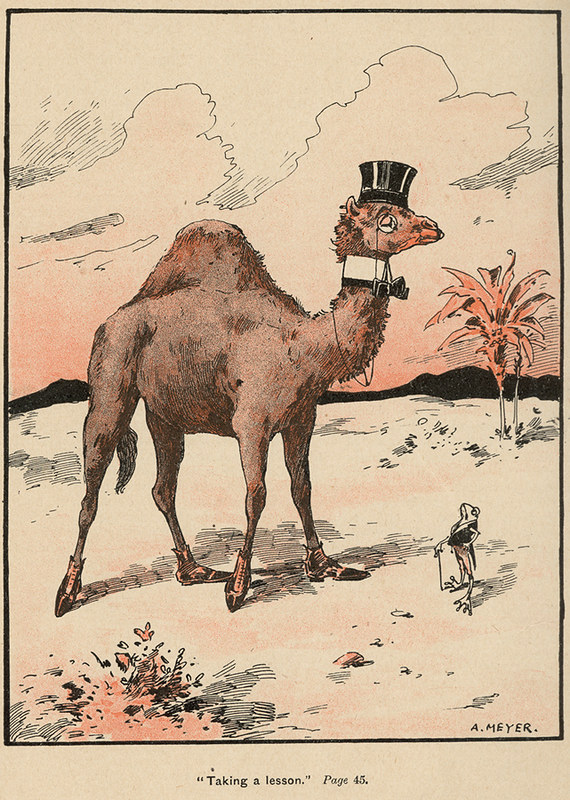
Shown above: A camel takes lessons in conceit and snobbery from a well-dressed frog.
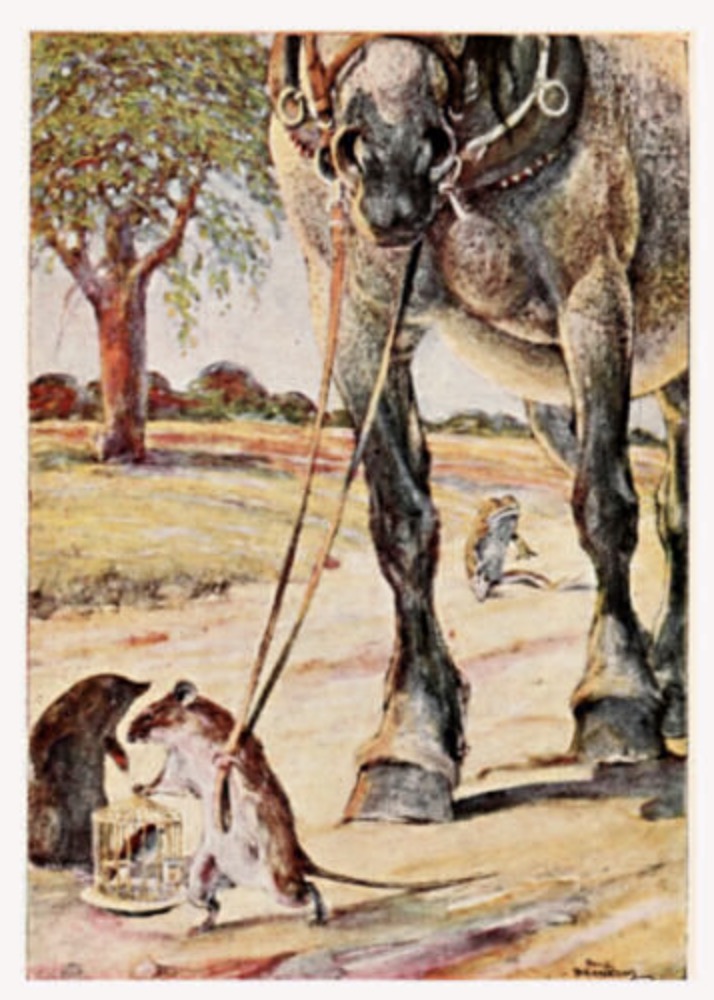
TOAD: In the first illustrated edition (1913) of Kenneth Grahame’s instant-classic 1908 children’s book The Wind in the Willows, I for one was surprised to discover, the character Toad doesn’t wear a waistcoat or top hat. In fact, he doesn’t wear anything — nor do his friends Mole, Rat, and Badger.
Grahame’s Toad is a delightful, unforgettable character, who revalues every value: He is proud instead of humble, lazy instead of industrious. He lies, cheats, and steals in pursuit of his obsessive passions. “Ho, ho! I am The Toad, the handsome, the popular, the successful Toad!” he exults.
Toad is the bumptious-est of frogs. Unlike his predecessors, he is not merely self-satisfied. He is a monster of egotism; he suffers from a surfeit of selfhood. He is larger than life! As such, he will become the exemplary frog of twentieth-century pop culture… until Kermit, that is.
Toad’s song:
The clever men at Oxford
Know all that there is to be knowed.
But they none of them know one half as much
As intelligent Mr. Toad!
As we’ll see below, subsequent Wind in the Willows illustrators would connect the dots between Grahame’s Toad and the pre-existing Victorian dandified-frog meme. Though they’d put an Edwardian spin on his look….
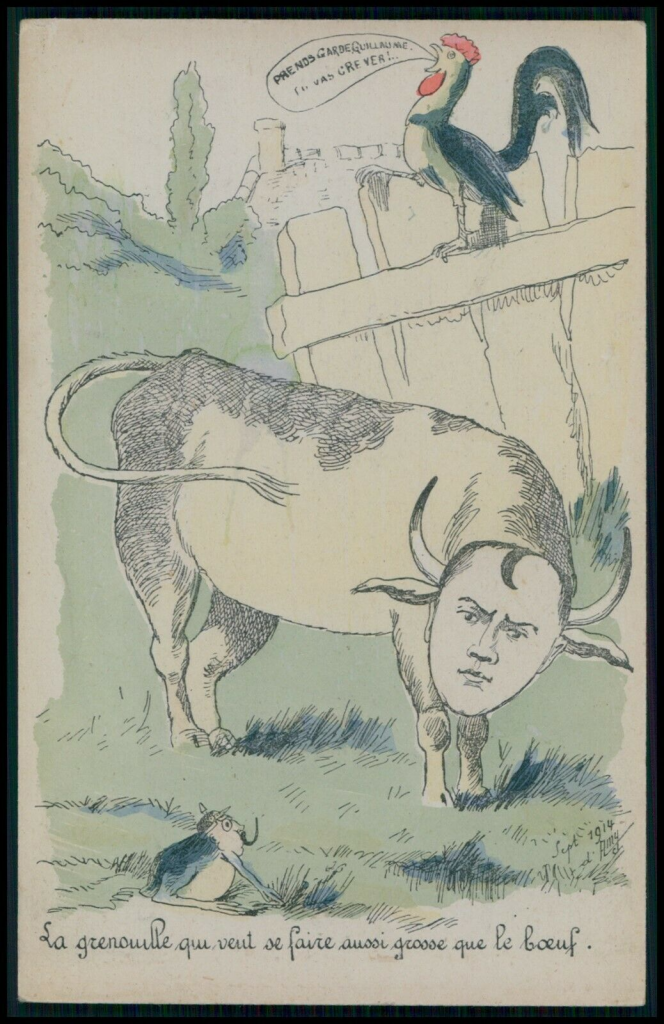
On 28 June 1914, a Bosnian Serb Yugoslav nationalist assassinated the Austro-Hungarian heir Archduke Franz Ferdinand in Sarajevo. Austria-Hungary issued an ultimatum to Serbia, and the two moved to a war footing. A network of interlocking alliances enlarged the crisis. By July, the great powers of Europe were divided into the Triple Entente, consisting of France, Russia, and Britain, and the Triple Alliance of Germany, Austria-Hungary, and Italy.
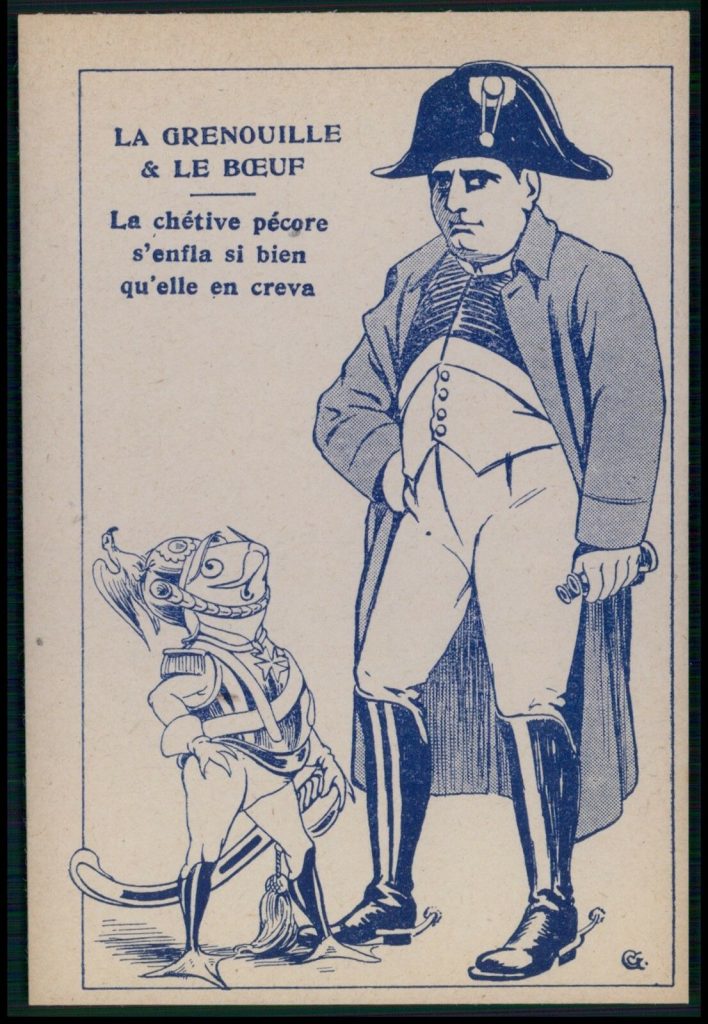
Aesop’s fable about a frog that tries to inflate itself to the size of an ox, but bursts in the attempt, was during this period often used to mock Germany’s Kaiser Wilhelm II, who — as we can see in the two postcards here — was depicted as a wannabe Napoleon in the form of a foolish, diminutive frog.
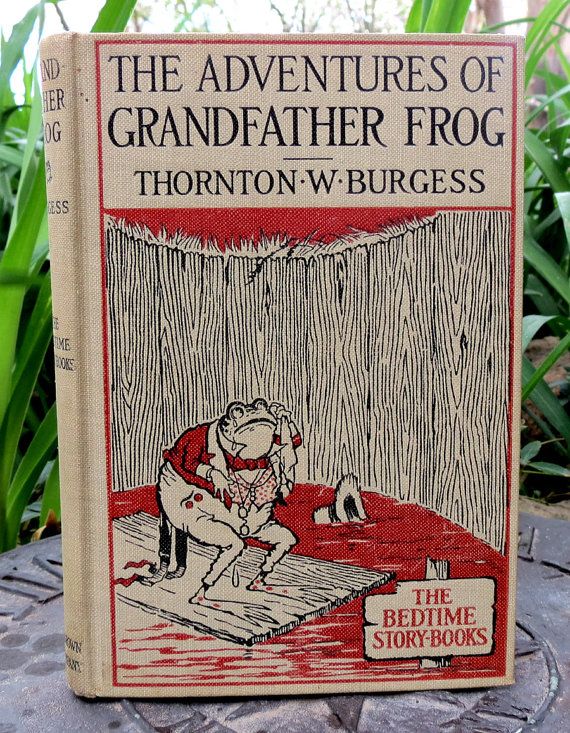
GRANDFATHER FROG: The American conservationist Thornton Waldo Burgess, known as the Bedtime Story-Man because of his popular newspaper column, Bedtime Stories, would eventually write more than 170 books and and 15,000 installments of his column. One of his more popular characters, Grandfather Frog, first appeared in the 1915 book The Adventures of Grandfather Frog. (Note that another of Burgess’s characters, Paddy Beaver, was mentioned in a previous installment in the BESTIARY series.)
As you can see from the cover above, Grandfather Frog is nattily dressed. He is also a figure of fun:
But once in a while his big mouth gets him into trouble. It’s a way big mouths have. It holds so much that it makes him greedy sometimes. He stuffs it full after his stomach already has all that it can hold, and then of course he can’t swallow. Then Grandfather Frog looks very foolish and silly and undignified, and everybody calls him a greedy fellow who is old enough to know better and who ought to be ashamed of himself. Perhaps he is, but he never says so, and he is almost sure to do the same thing over again the first chance he has.
Subsequent Grandfather Frog books include: Grandfather Frog Stays in the Smiling Pool (1922), Grandfather Frog Gets a Ride (1927), and Grandfather Frog Fools Farmer Brown’s Boy.
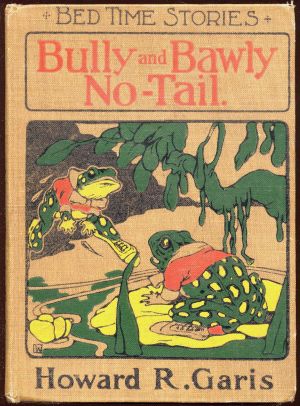
BULLY & BAWLY NO-TAIL. Frog boys who live in a pond near a farm, having fun adventures — sometimes in the company of Garis’s most famous creation, the rabbit Uncle Wiggily.
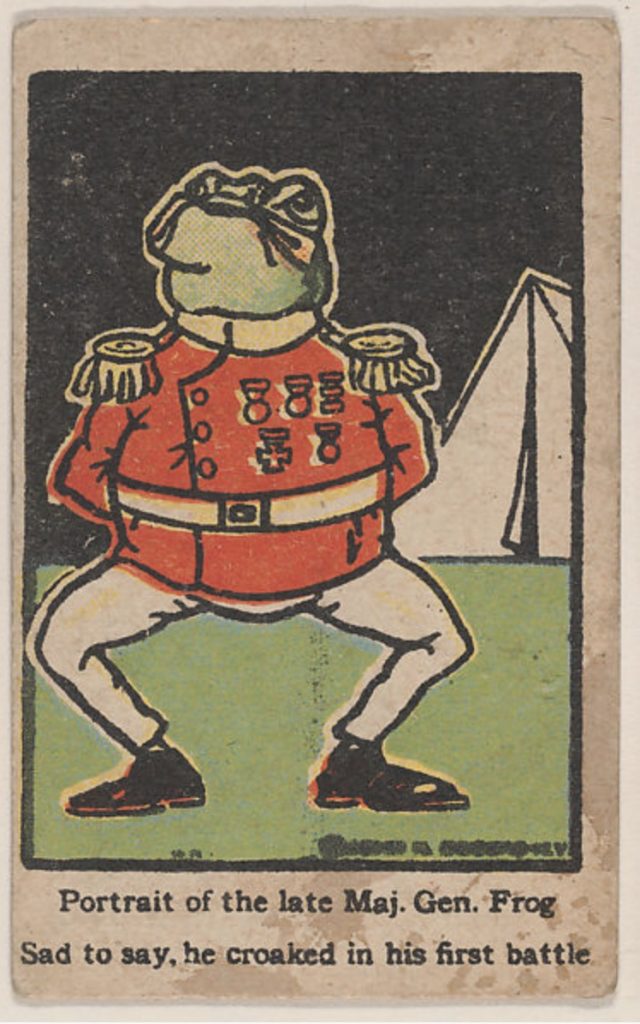
MAJ. GEN. FROG: Here’s another buffoonish warmongering frog. The John H. Eggers Co. produced humorous cards like this one, as well as miniature books — but for what purpose? How did one get them? Inside packs of cigarettes? I’d like to learn more.
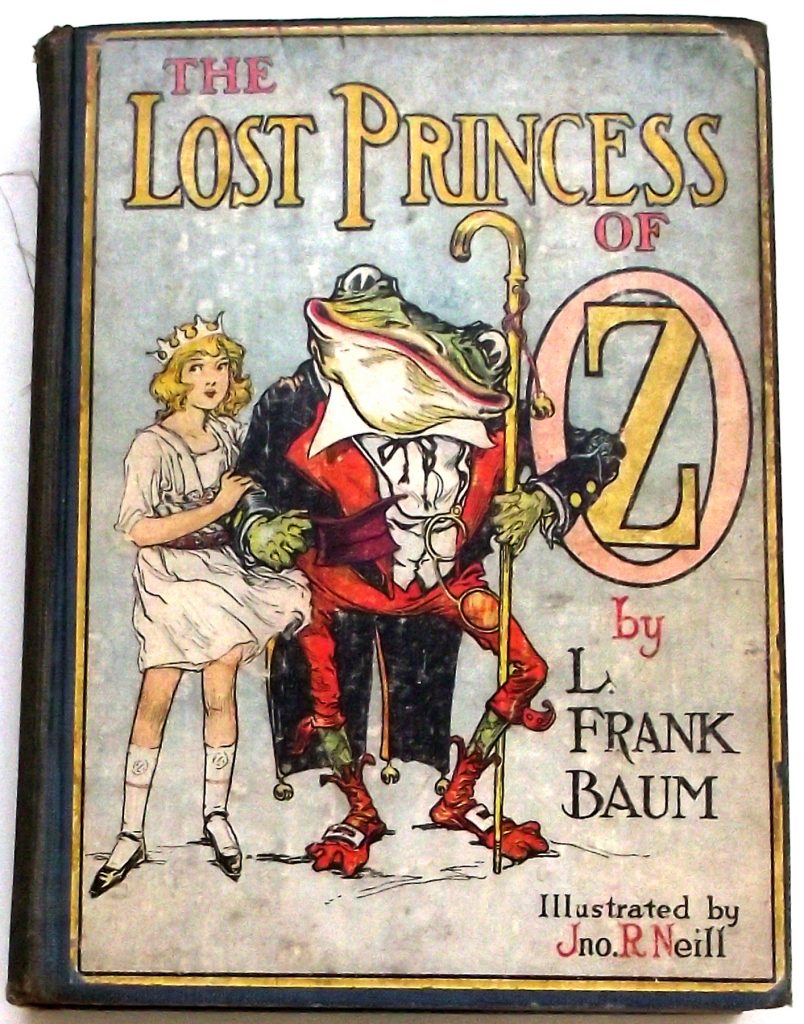
THE FROGMAN. In the eleventh Oz book written by L. Frank Baum, Dorothy and the Wizard search for the missing Princess Ozma. Meanwhile, a human-sized dandy of a frog called the Frogman seeks a missing magical dishpan. These two quests turn out to have something in common…. The Frogman is a puffed-up type, who has appointed himself advisor to a people known as the Yips, though he knows nothing at all.
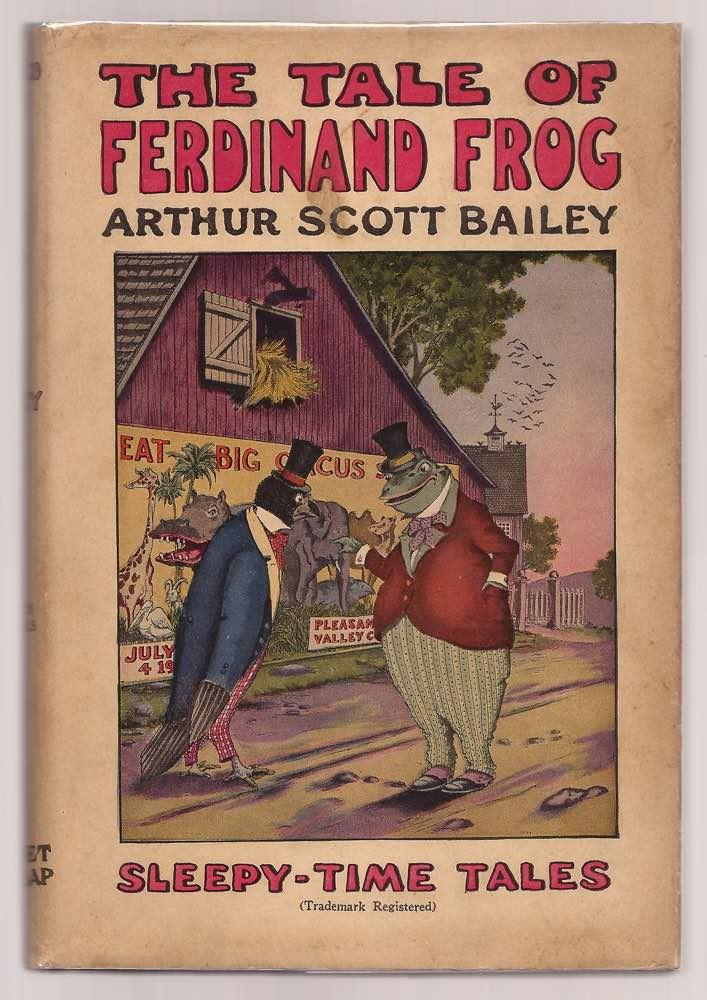
FERDINAND FROG: The 1918 story The Tale of Ferdinand Frog. I’ve mentioned elsewhere that Arthur Scott Bailey’s 1916 book The Tale of Brownie Beaver deserves to be credited as the progenitor of the alliteratively named fictional beaver meme. With Ferdinand Frog, he’s done it again.
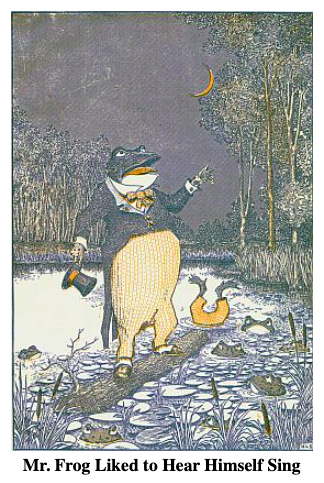
Ferdinand is a tailor — hence his natty outfits — and something of a goofball. Here’s an excerpt:
There was something about Ferdinand Frog that made everybody smile. It may have been his amazingly wide mouth and his queer, bulging eyes, or perhaps it was his sprightly manner—for one never could tell when Mr. Frog would leap into the air, or turn a somersault backward. Indeed, some of his neighbors claimed that he himself didn’t know what he was going to do next—he was so jumpy.
Note that Tired Tim, a “bank beaver” from The Tale of Brownie Beaver, makes an appearance in this book too.
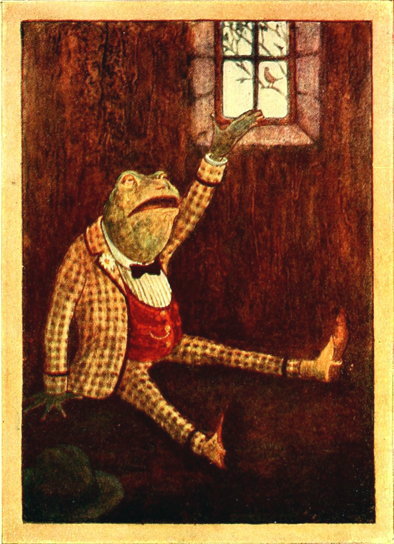
Nancy Barnhart’s 1922 illustrations for The Wind in the Willows gives us a nattily dressed Toad — waistcoat, bowtie, spats, the works. This is how he has been depicted ever since!
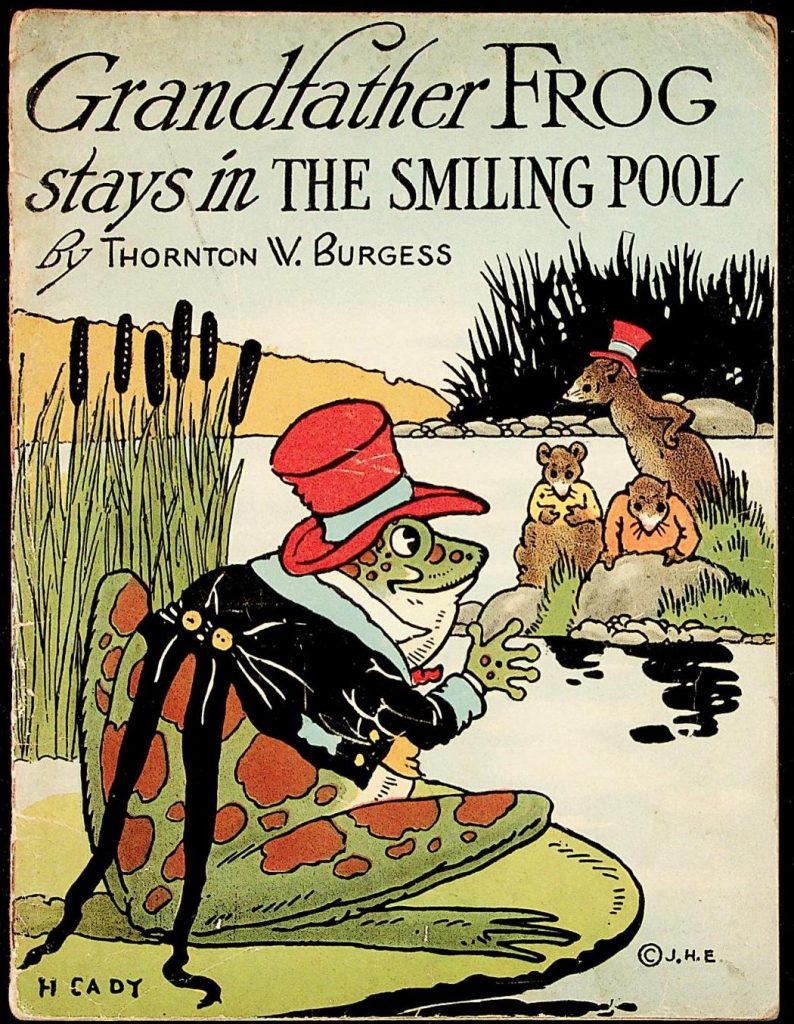
And here’s a 1922 Grandfather Frog adventure.
More of the same sort of thing during the Twenties…
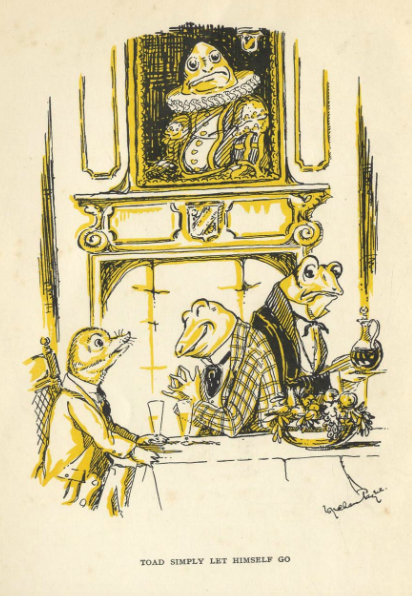
Wyndham Payne’s 1927 illustrations for The Wind in the Willows continue to depict Toad as a natty dresser.
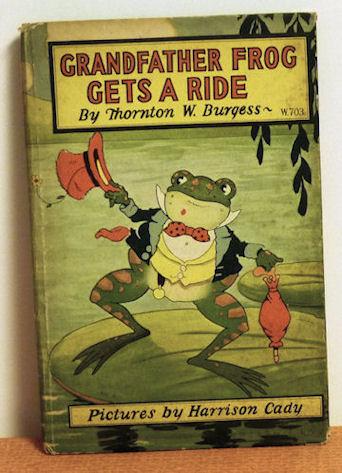
Grandfather Frog continues to be a disreputable but natty dresser. I guess the term I’m looking for is “raffish.”
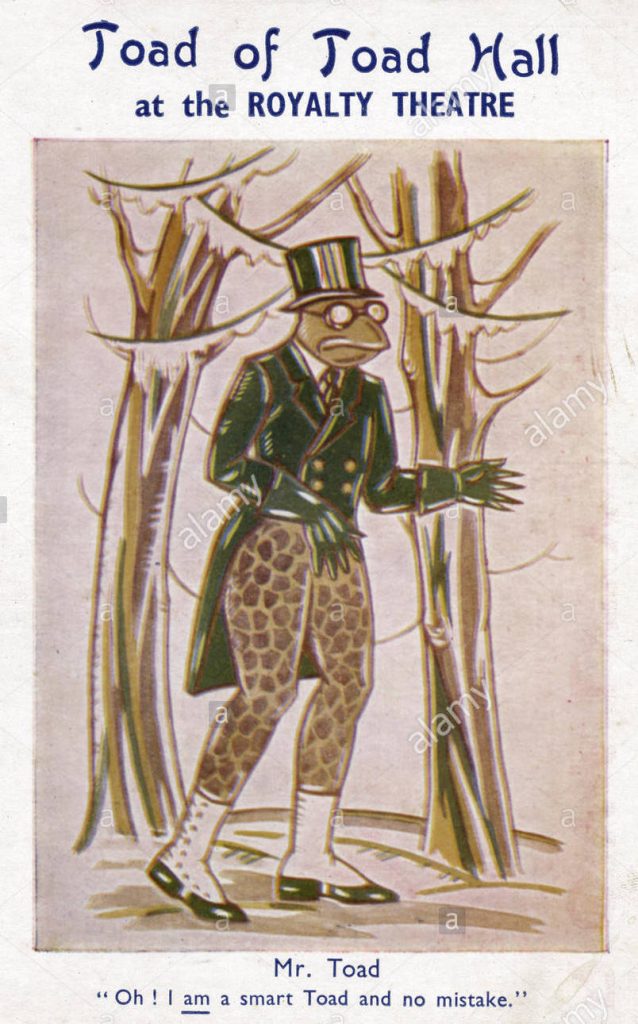
In 1929, A. A. Milne — whose Winnie-the-Pooh was published in 1926, followed by The House at Pooh Corner in 1928 — published a play version of Kenneth Grahame’s The Wind in the Willows. He ruthlessly excised all the slow-moving, nature-loving bits and focused on Toad’s adventures. Milne’s adaptation, Toad of Toad Hall, first appeared in London in 1930. It was a hit, and it has influenced public perception of Grahame’s book ever since. (Which is too bad, it’s an extraordinary book.)
Milne’s take on Toad begins to move the pop-culture frog discourse from “bumptious” to “rapscallion.” Toad, of course, is both.
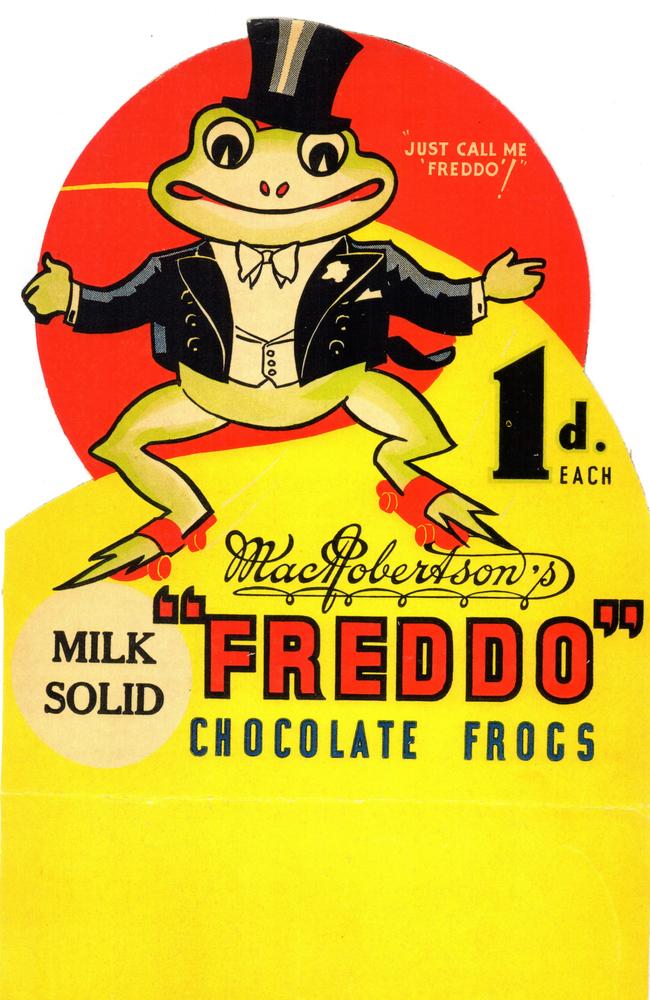
FREDDO THE FROG: Freddo is a chocolate bar brand shaped like an anthropomorphic cartoon frog. The brand was originally manufactured by an Australian confectionery company, but was acquired and is now produced by Cadbury.
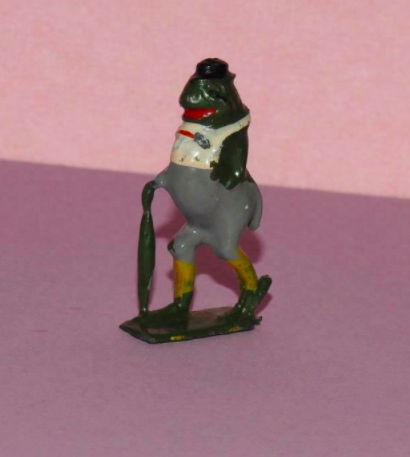
Freddo the Frog is still around, though now he’s become a sort of Dig’em-style, t-shirt wearing youth. On packages in Australia, meanwhile, Freddo has been replaced by images of real frogs — to bring attention to their endangered status.
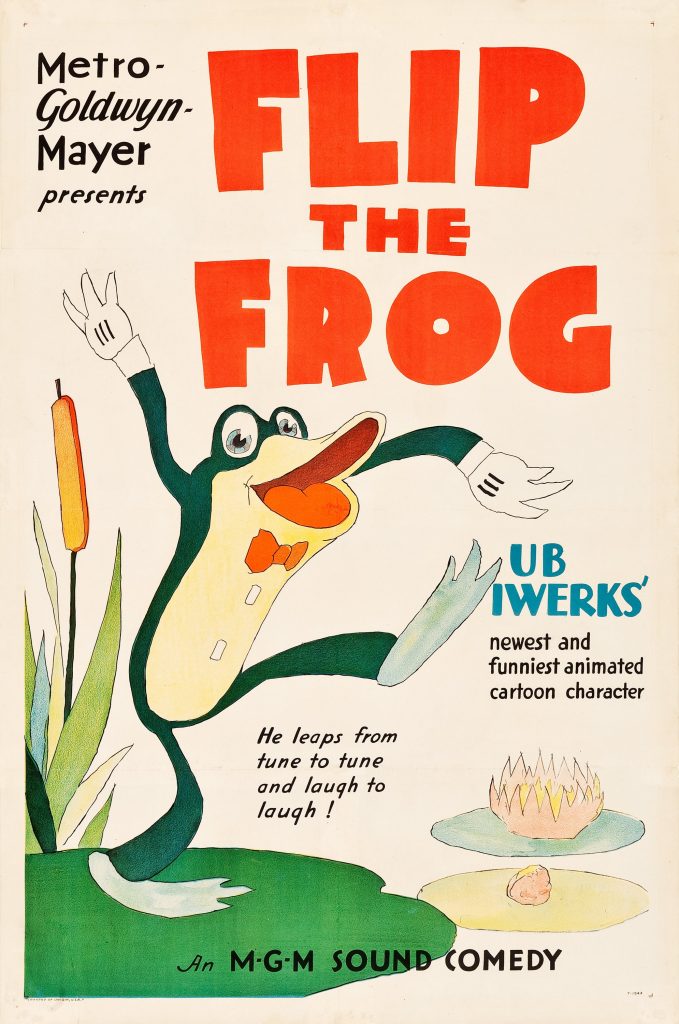
FLIP THE FROG: Flip the Frog is a cartoon character created by Ub Iwerks. He starred in a series of cartoons distributed by MGM beginning in 1930. Flip’s appearance morphed rapidly, becoming ever less froglike; at the same time, he became more of a down-and-out, Chaplin-esque character. A scamp, or rapscallion. In this early film, Fiddlesticks, he is very froggish — although he sports a bowtie (and buttons suggesting a waistcoat). The final Flip short, Soda Squirt, which was released in 1933, features a character who looks quite different.
Note that Mickey Mouse knockoff in Fiddlesticks — a joke on the part of Iwerks, who’d developed the MM character before falling out with Disney.
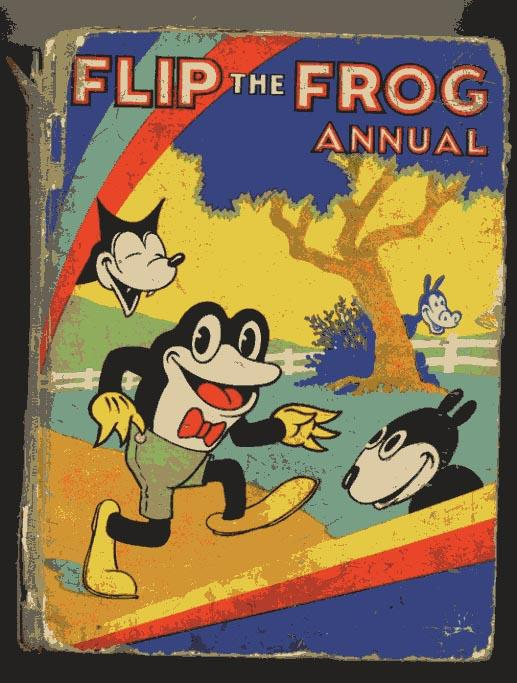
In 1932, a Flip the Frog Annual was issued in England with the permission of Ub Iwerks. It was drawn by Wilfred Haughton. The Annual only ran for one edition, because of Flip the Frog’s lack of popularity. Perhaps the turn to the rapscallion frog was too soon? Iwerks, as always, was ahead of his time.
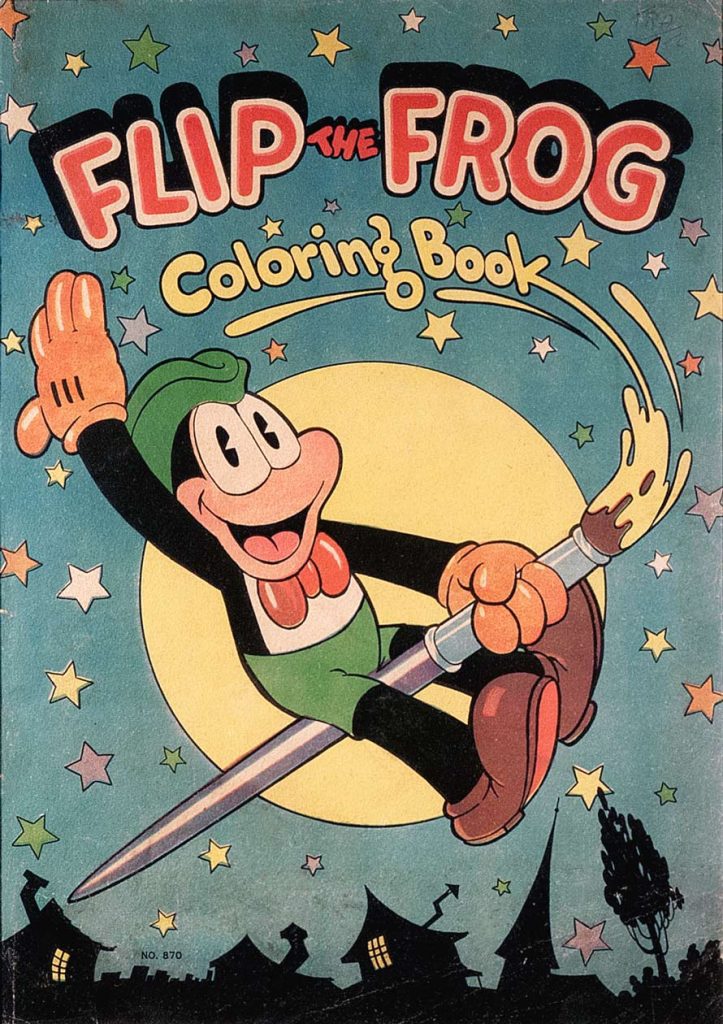
In the 1931 Flip the Frog cartoon Ragtime Romeo there’s a cheeky scene in which a photo of Flip peeps at his undressed girlfriend. And here’s the 1931 Flip cartoon Movie Mad.
There’s lots of Flip the Frog merch showcased here, including the semi-obscene image above.
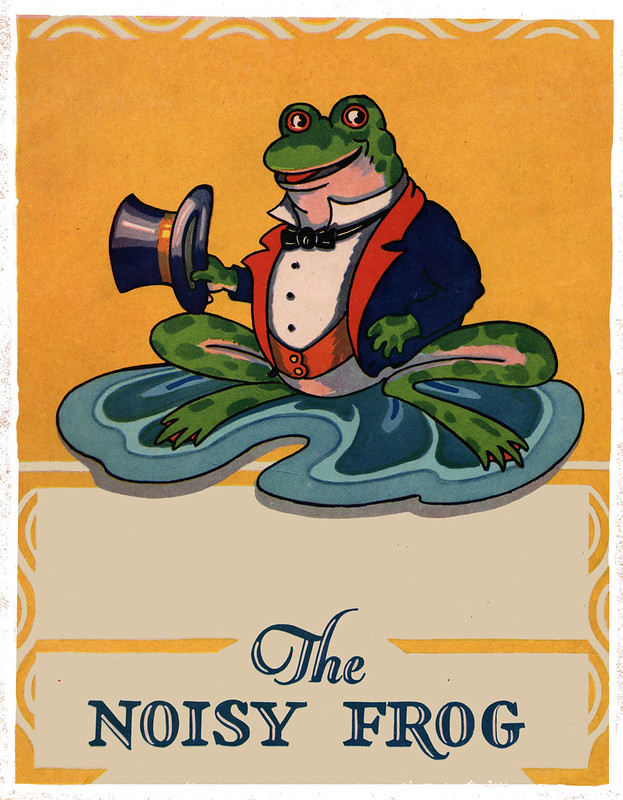
The 1930 book Gabby Goose and Her Friends by Helen M. Stockton, and illustrated by Grace Phillips, features a very charismatic, nattily dressed, bumptious frog.

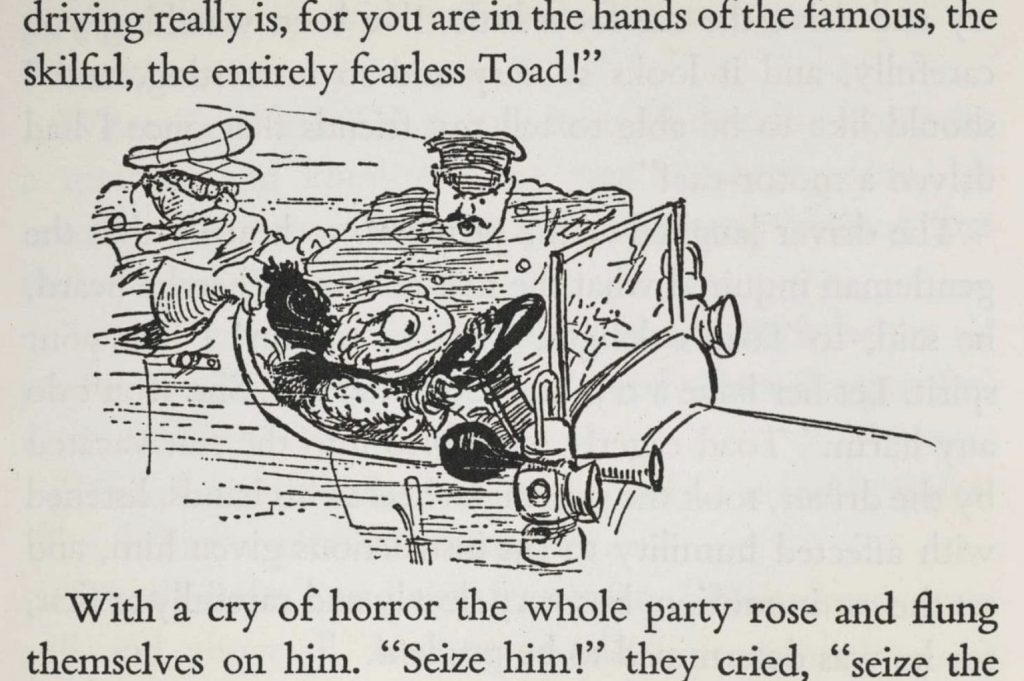
The most popular illustrations for Wind in the Willows are probably those by E. H. Shepard, originally published in 1931. Shepard, well-known for his illustrations of Milne’s Winnie the Pooh books, was asked to illustrate a new edition of Grahame’s book following Milne’s stage adaptation, Toad of Toad Hall.
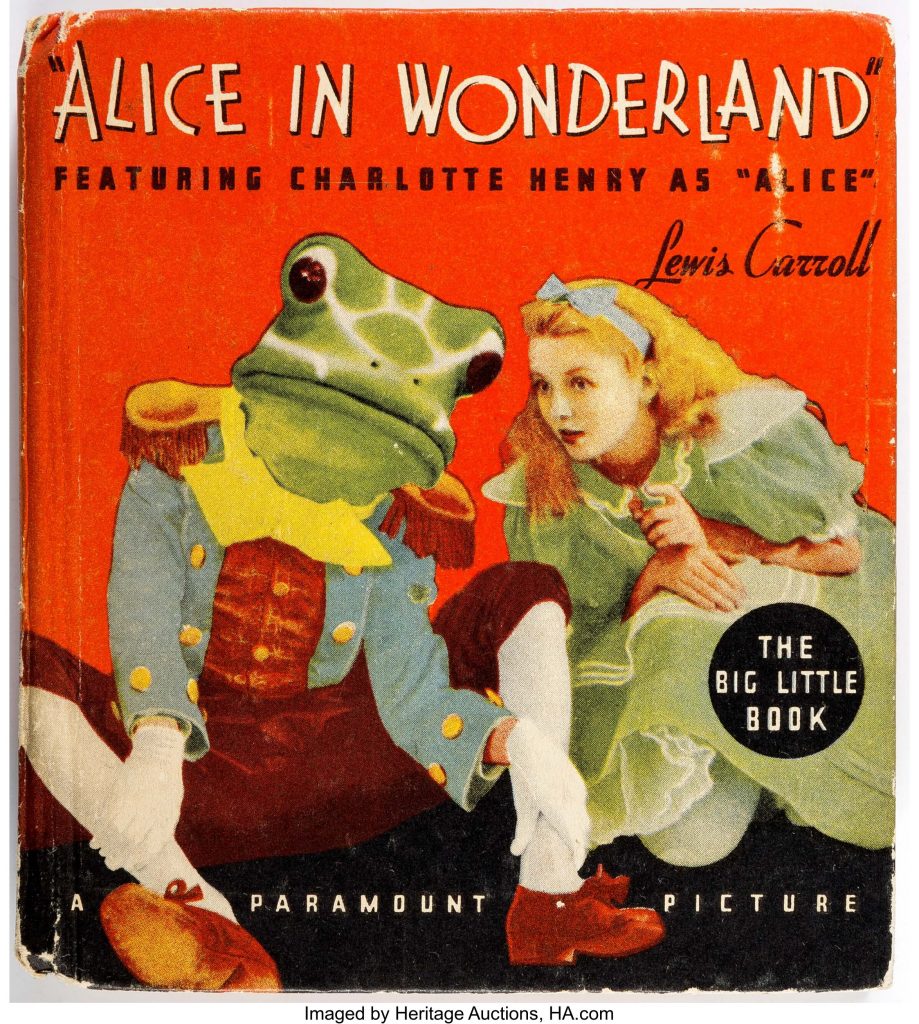
The 1933 Paramount Picture adaptation of Alice in Wonderland features an all-star cast: W. C. Fields as Humpty Dumpty, Edna May Oliver as the Red Queen, Cary Grant as the Mock Turtle, Gary Cooper as The White Knight, Edward Everett Horton as The Hatter, Charles Ruggles as The March Hare, Baby LeRoy as The Joker, and Charlotte Henry in her first leading role as Alice. The cover of the photoplay book version, above, features the movie’s Frog Gardener.
NEXT “LEG”: 1934–1963.
FOOTNOTES
[1] FIGURINES.
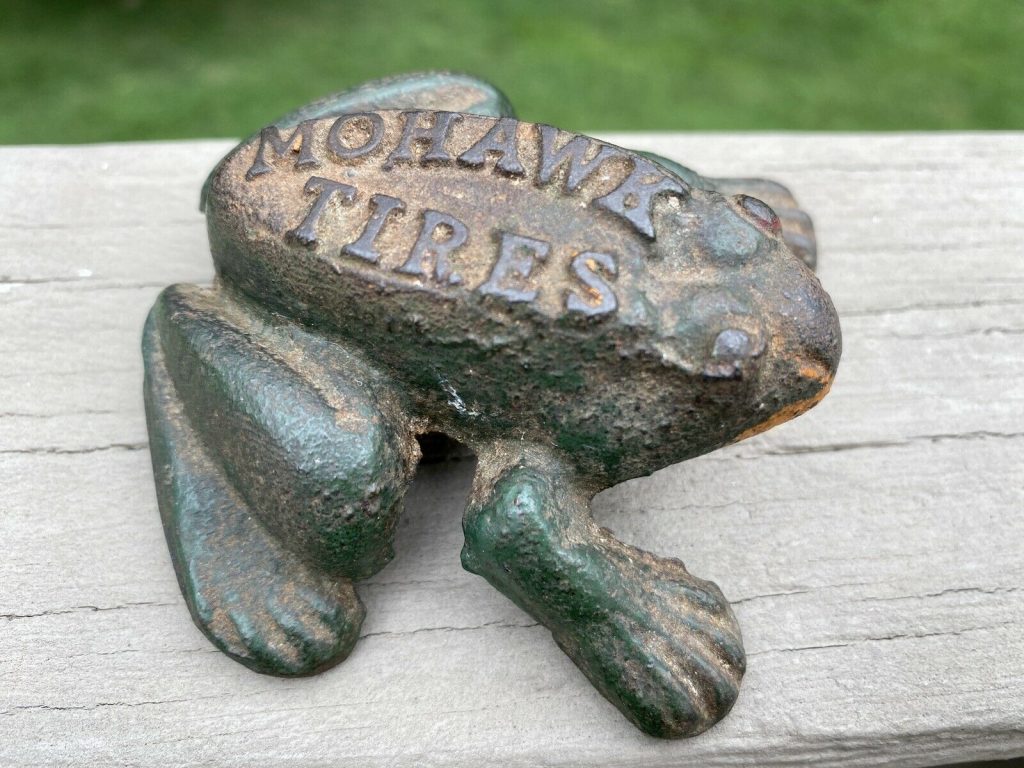
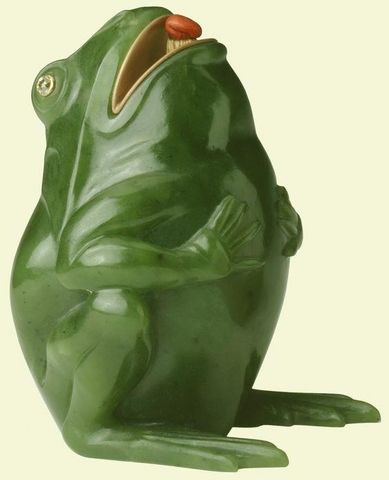
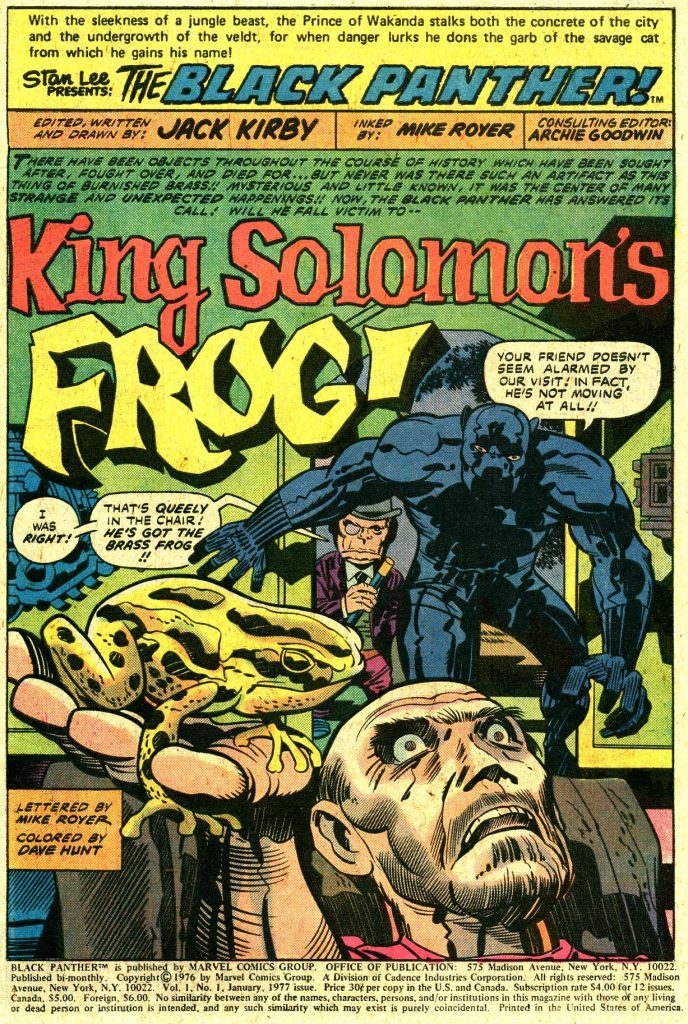
[2] HYPNOTIC.
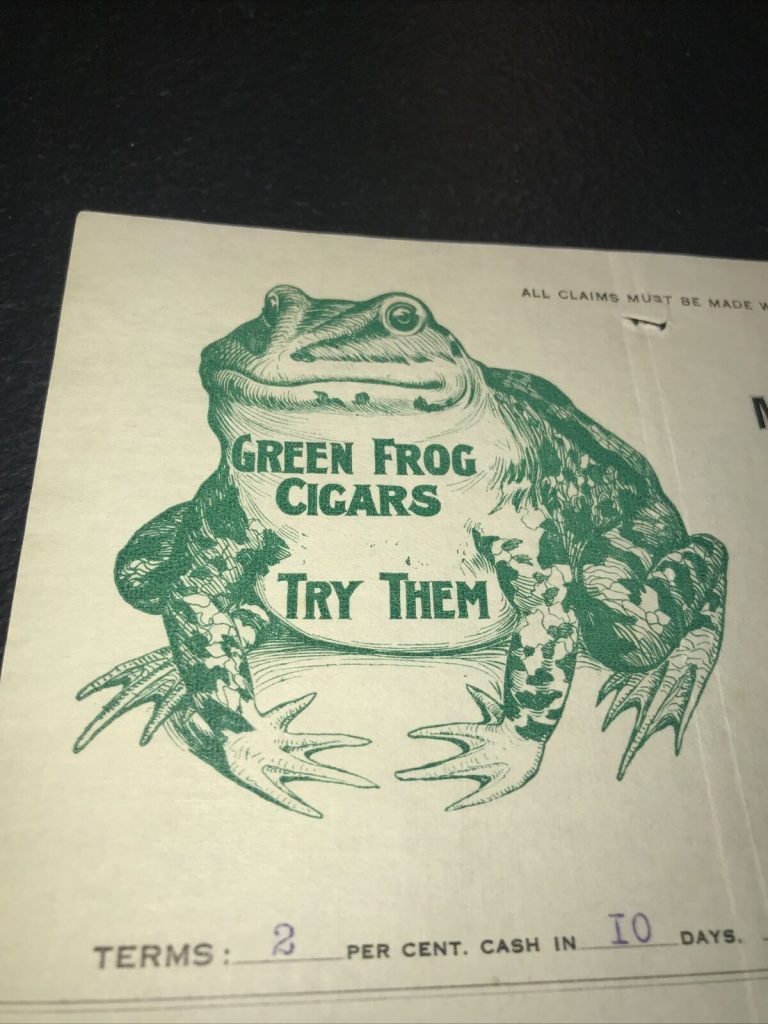
The original Hypno Toad?
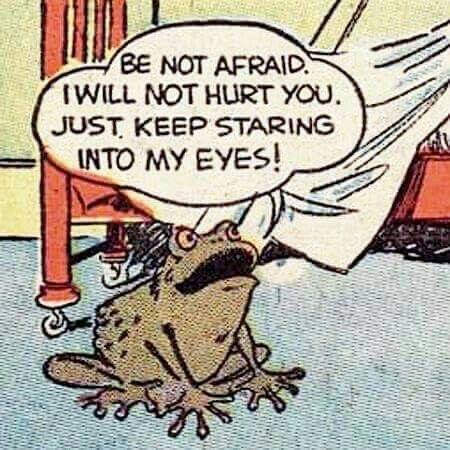
Undated midcentury comic book panel that I recently came across.
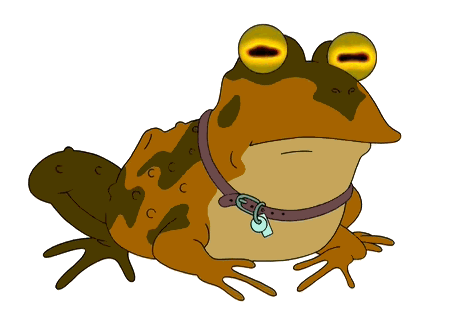
The villainous Hypnotoad first appeared in “The Day the Earth Stood Stupid,” a 2001 episode of Futurama.
See more examples in an upcoming standalone post on HYPNOTIC FROGS.
[3] HORROR & VILLAINY.
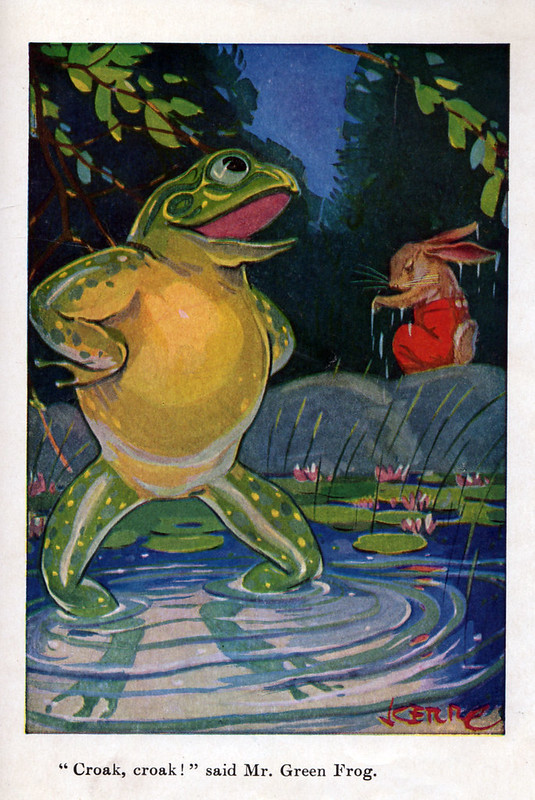
MR. GREEN FROG: Mr Green Frog seems to be something of a dick. He’s also a kind of proto-Creature from the Black Lagoon — huge, humanoid, menacing.
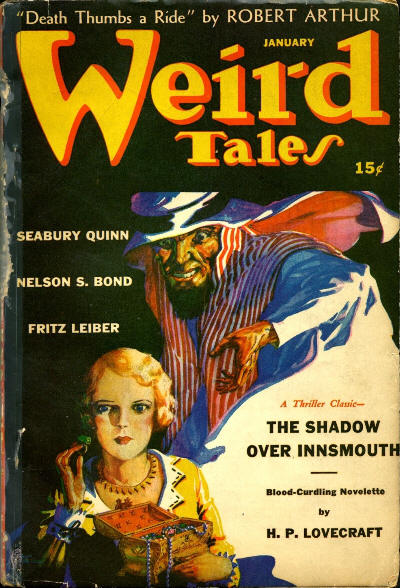
H.P. Lovecraft’s The Shadow Over Innsmouth was published in 1931. It introduces us to the Deep Ones — humanoid beings with fish, human and amphibian-like traits, who are described as having grey-ish green, glossy and slippery skin with white stomachs. They have scaled, ridged backs, as well as webbed and clawed hands and gilled necks. They move about in an inhuman fashion, by hopping oddly, and occasionally move on all fours. They have abhorrent, croaking voices.
Note that Lovecraft was a fan of A. Merritt’s 1919 proto-sf novel The Moon Pool — see HILOBROW’s serialization. There are humanoid frogs involved.
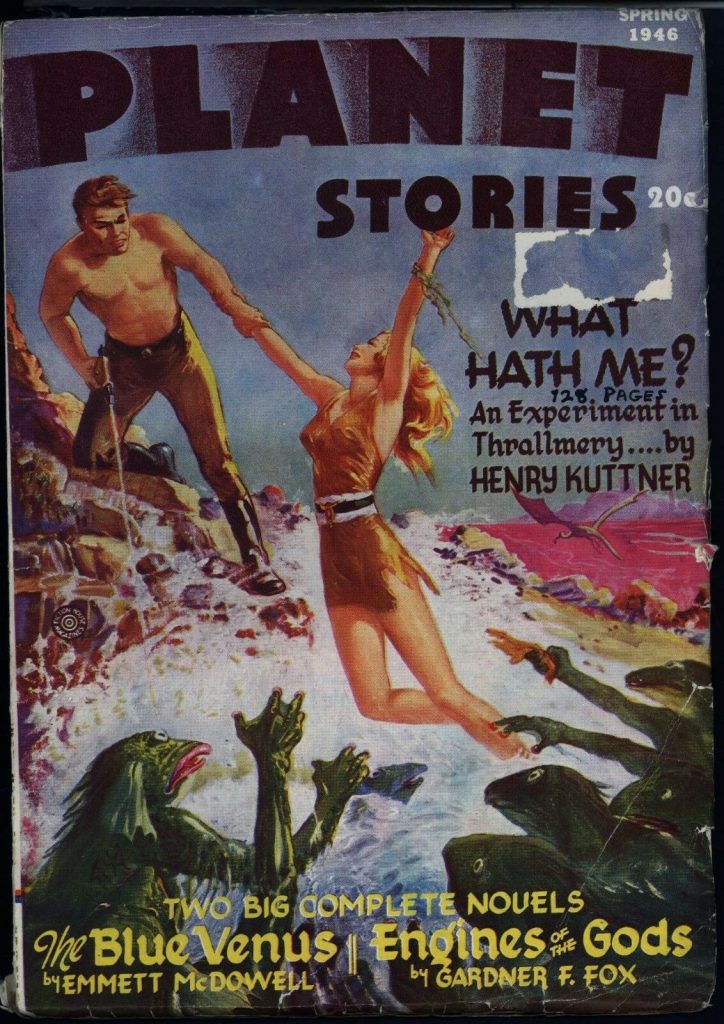
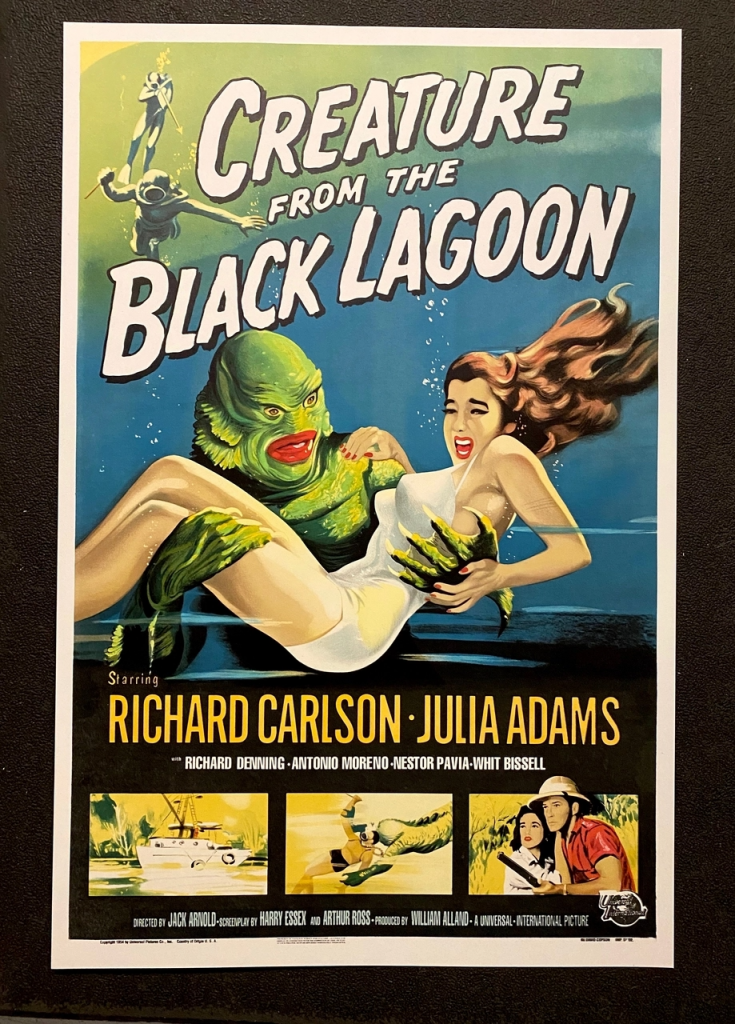
Creature from the Black Lagoon came out in 1954. Read Gerald Peary’s take on the movie here.
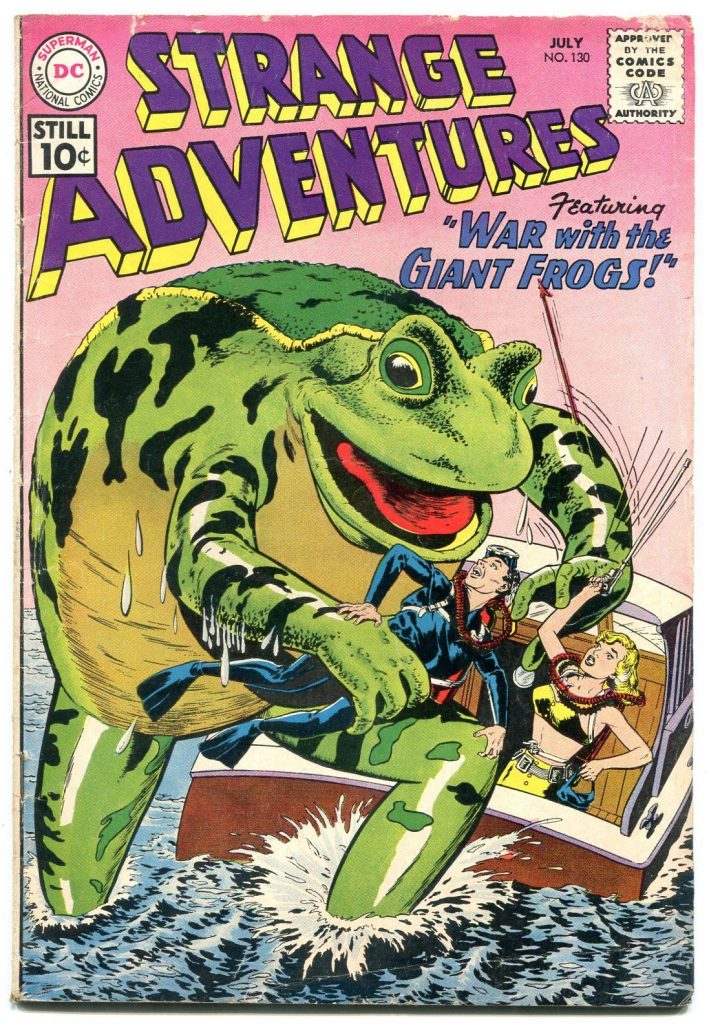
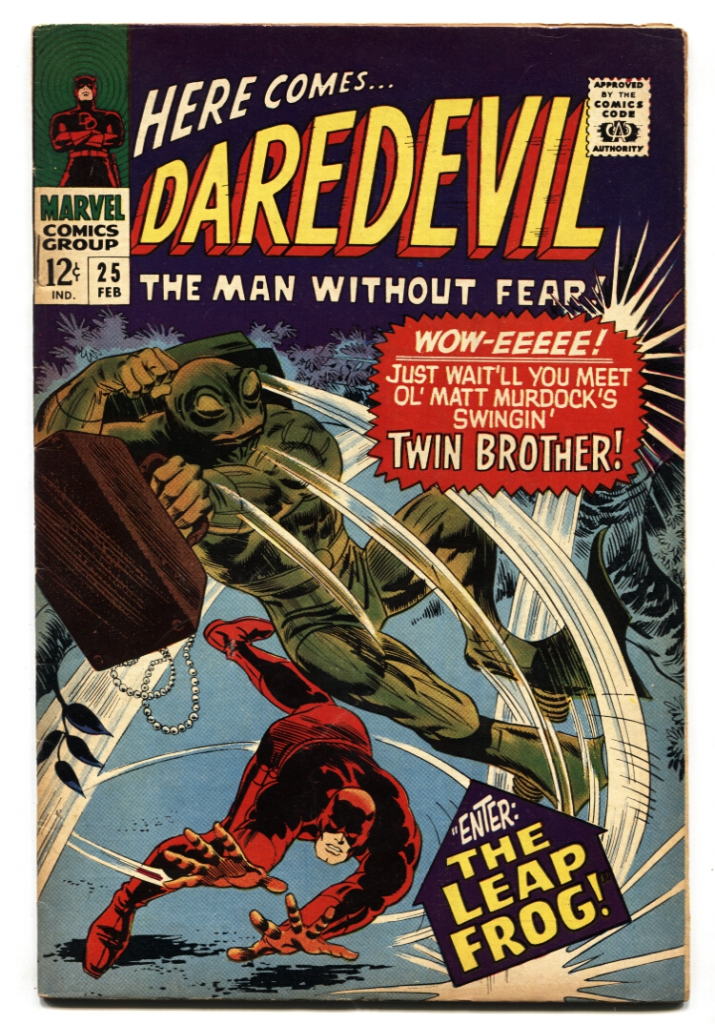
Daredevil was forced to deal with a toymaker who designed a pair of spring-based boots and embarked on a life of crime.
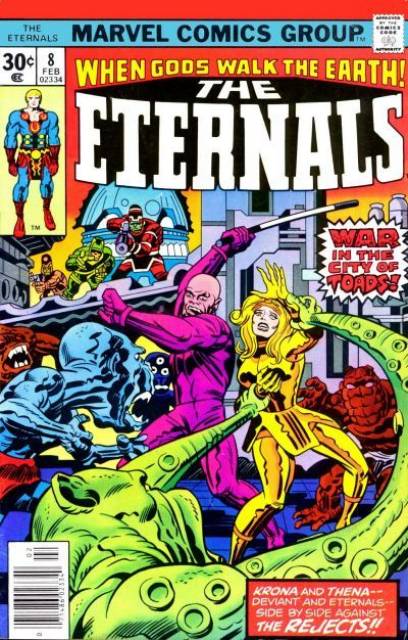
See more examples in an upcoming standalone post on SCARY FROGS.
[4] DISSECTION.
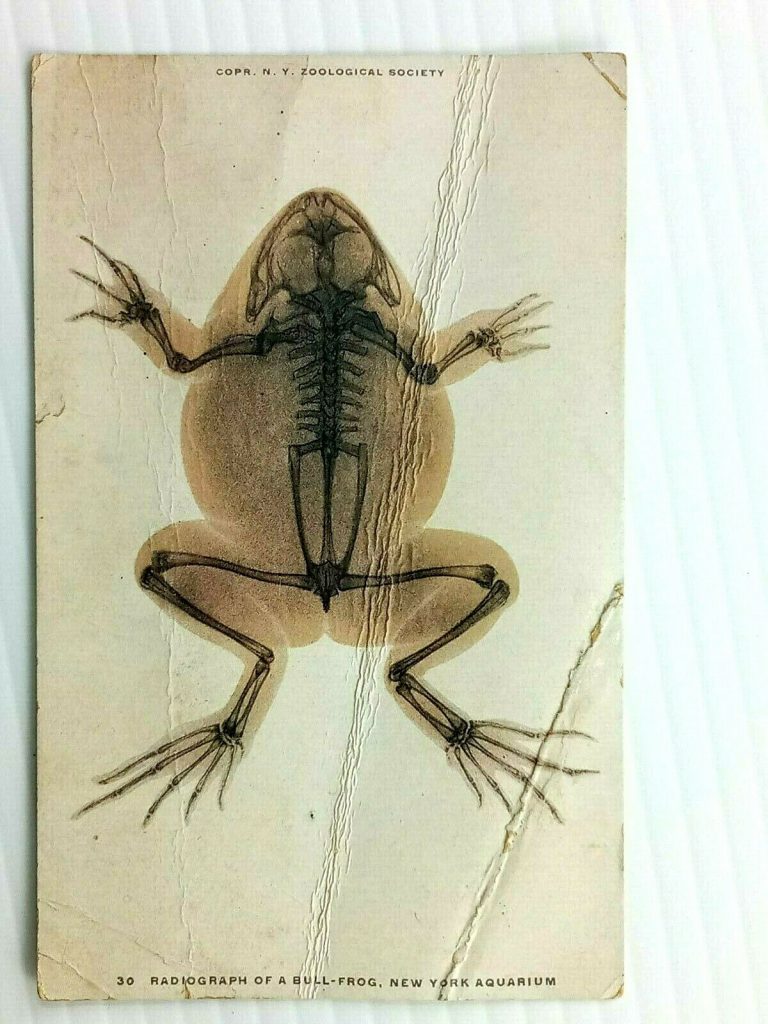
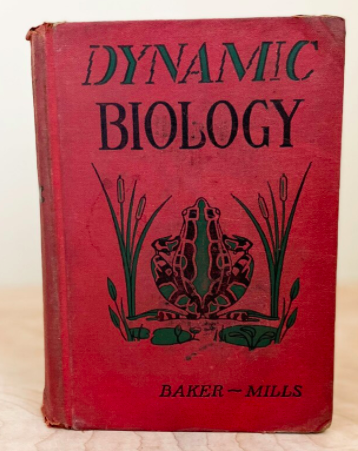
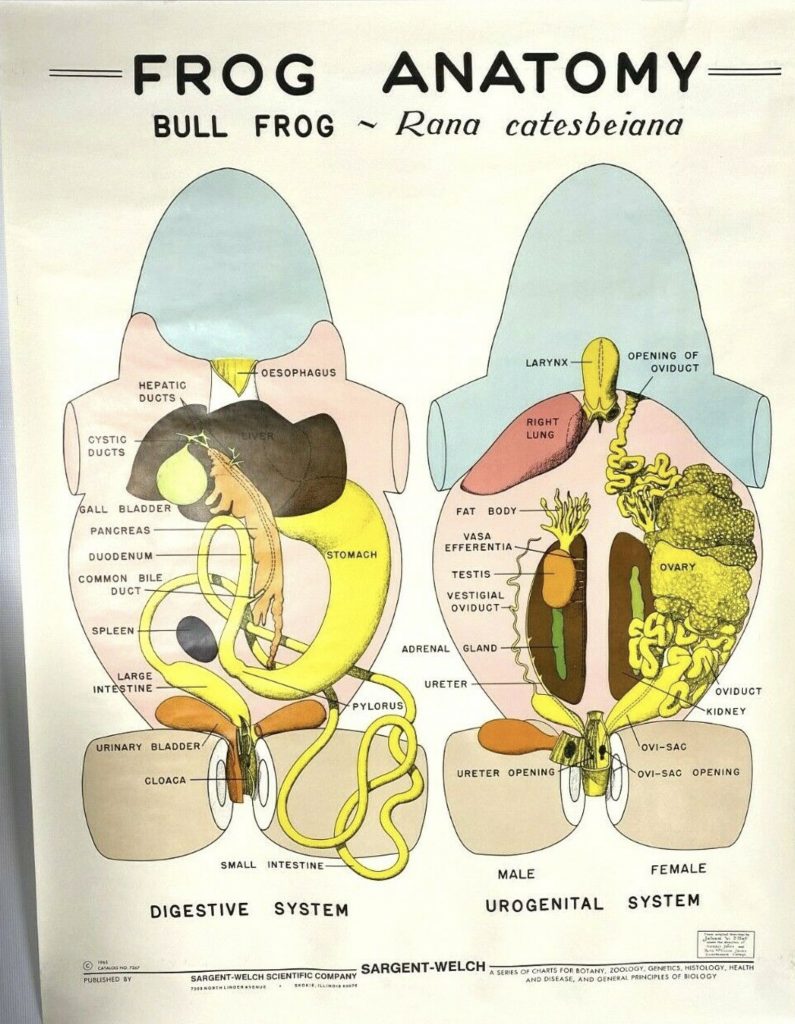
[5] MUSICAL FROGS.
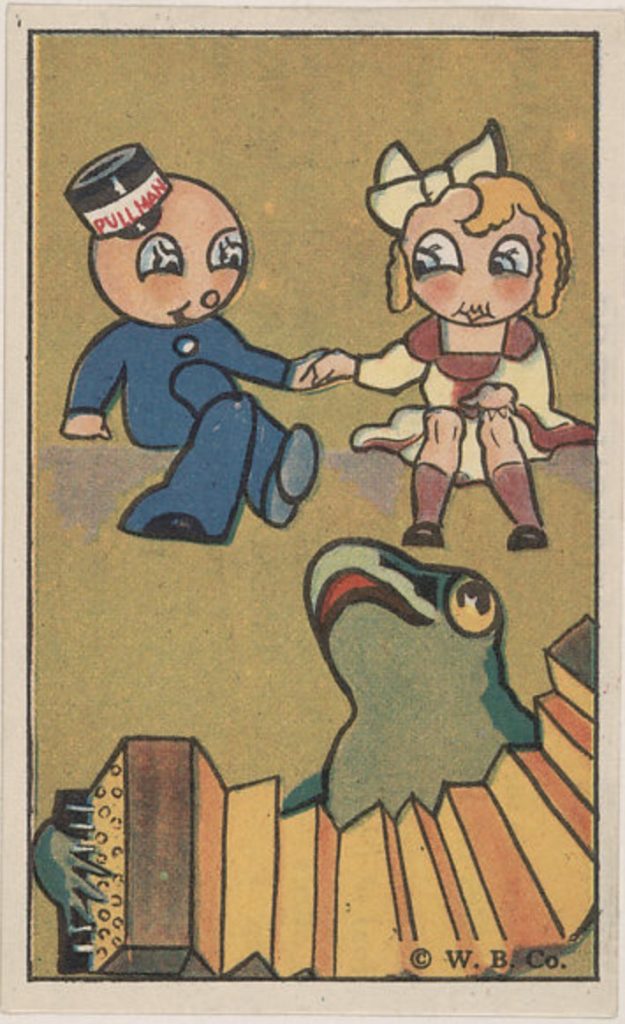
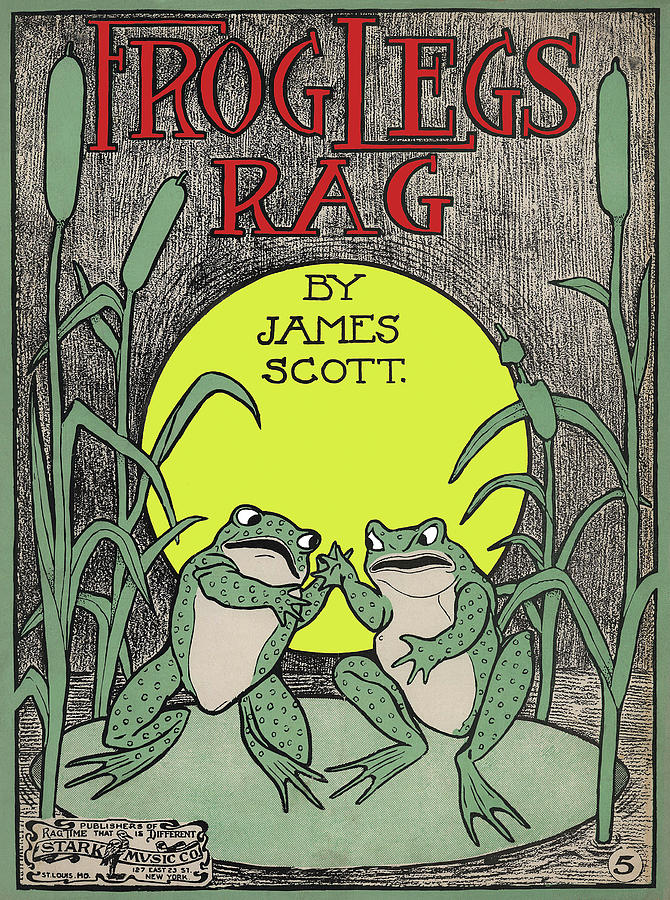
See the 1929 cartoon “Springtime.” Some very musical frogs.
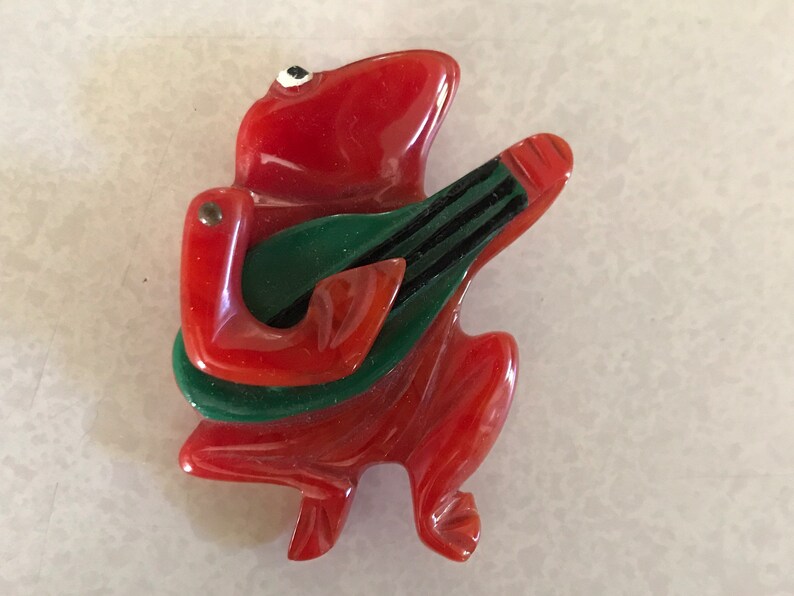

The Old Mill Pond is a 1936 American animated short film in MGM’s Happy Harmonies series. Fish and (nattily dressed) frogs gather at the old mill pond to hear a jazz concert. Cab Calloway, Fats Waller, ‘Bill “Bojangles’ Robinson’, Louis Armstrong, Stepin Fetchit, Ethel Waters and The Mills Brothers are caricatured.
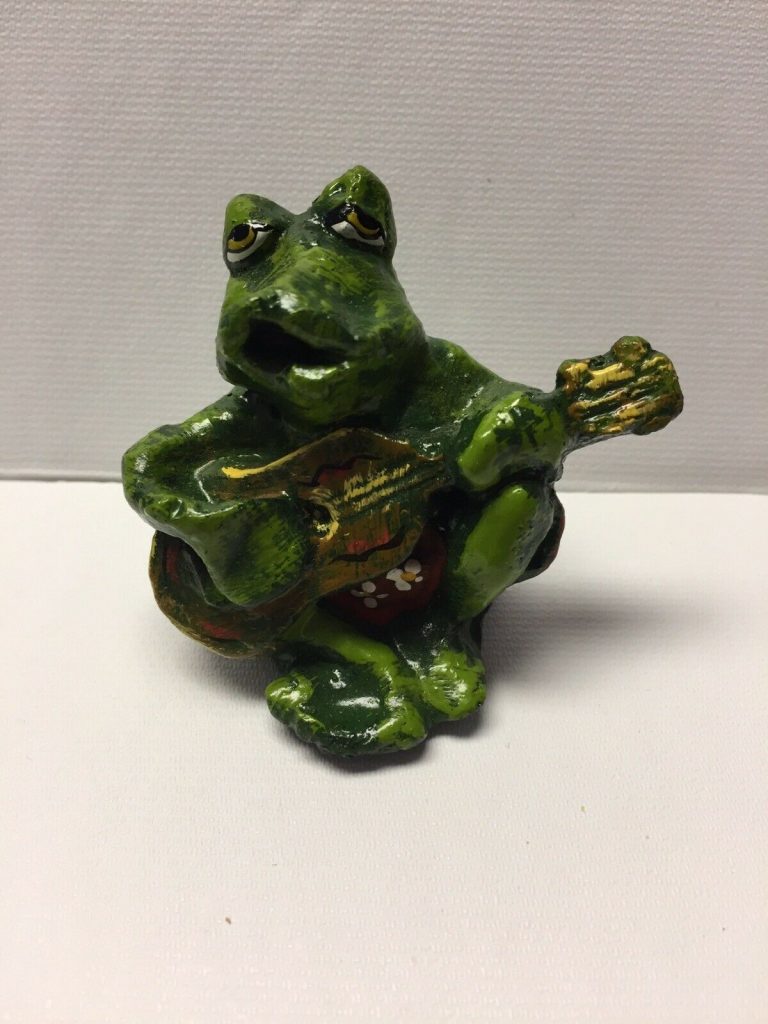
This 1977 frog figurine seems to have tuned in, turned on, dropped out… and lived to regret his youthful decisions.
See more examples in an upcoming standalone post on MUSICAL FROGS.
INTRODUCTION by Matthew Battles: Animals come to us “as messengers and promises.” Of what? | Matthew Battles on RHINO: Today’s map of the rhinoceros is broken. | Josh Glenn on OWL: Why are we overawed by the owl? | Stephanie Burt on SEA ANEMONE: Unable to settle down more than once. | James Hannaham on CINDER WORM: They’re prey; that puts them on our side. | Matthew Battles on PENGUIN: They come from over the horizon. | Mandy Keifetz on FLEA: Nobler than highest of angels. | Adrienne Crew on GOAT: Is it any wonder that they’re G.O.A.T. ? | Lucy Sante on CAPYBARA: Let us gather under their banner. | Annie Nocenti on CROW: Mostly, they give me the side-eye. | Alix Lambert on ANIMAL: Spirit animal of a generation. | Jessamyn West on HYRAX: The original shoegaze mammal. | Josh Glenn on BEAVER: Busy as a beaver ~ Eager beaver ~ Beaver patrol. | Adam McGovern on FIREFLY: I would know it was my birthday / when…. | Heather Kapplow on SHREW: You cannot tame us. | Chris Spurgeon on ALBATROSS: No such thing as a lesser one. | Charlie Mitchell on JACKALOPE: This is no coney. | Vanessa Berry on PLATYPUS: Leathery bills leading the plunge. | Tom Nealon on PANDA: An icon’s inner carnivore reawakens. | Josh Glenn on FROG: Bumptious ~ Rapscallion ~ Free spirit ~ Palimpsest. | Josh Glenn on MOUSE.
